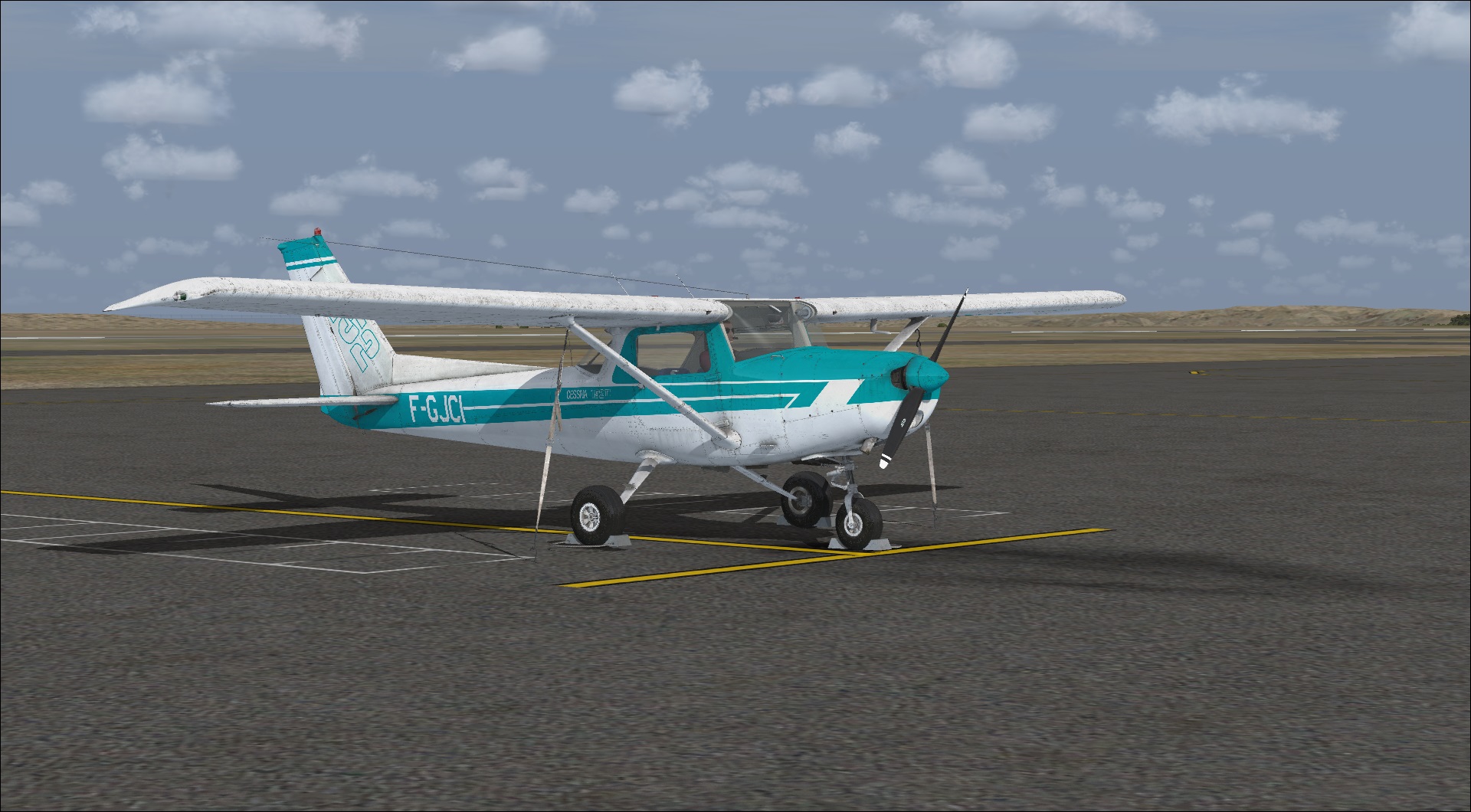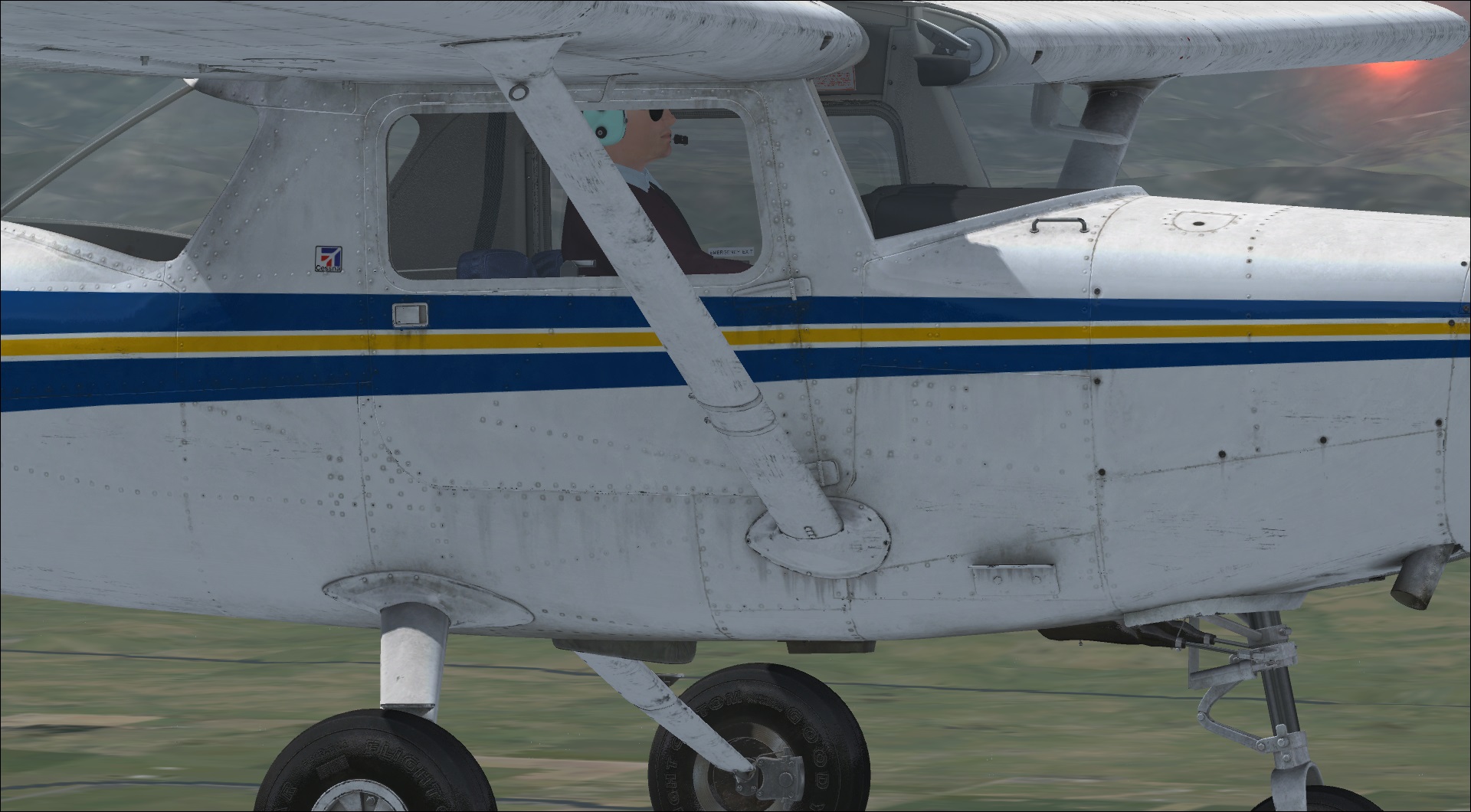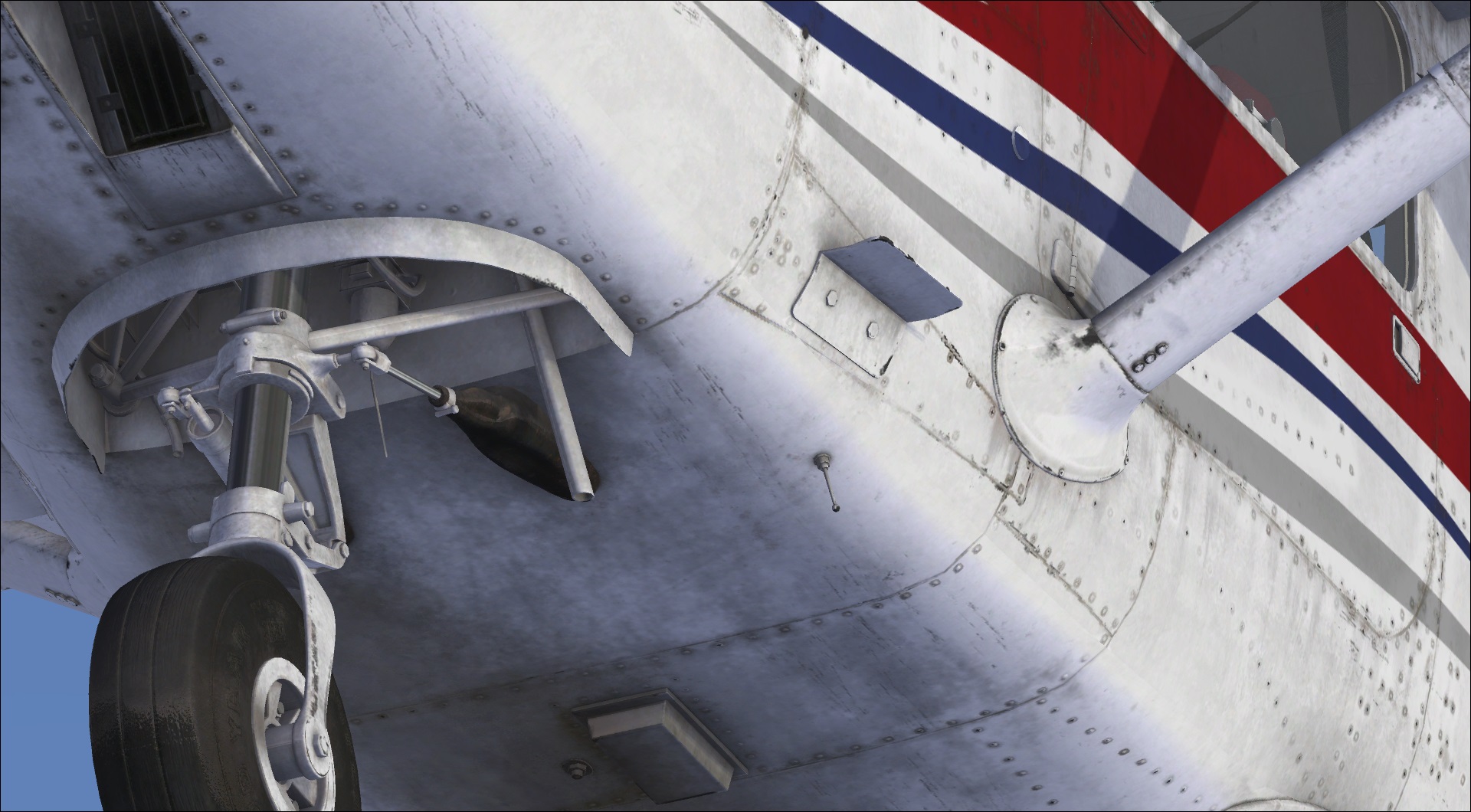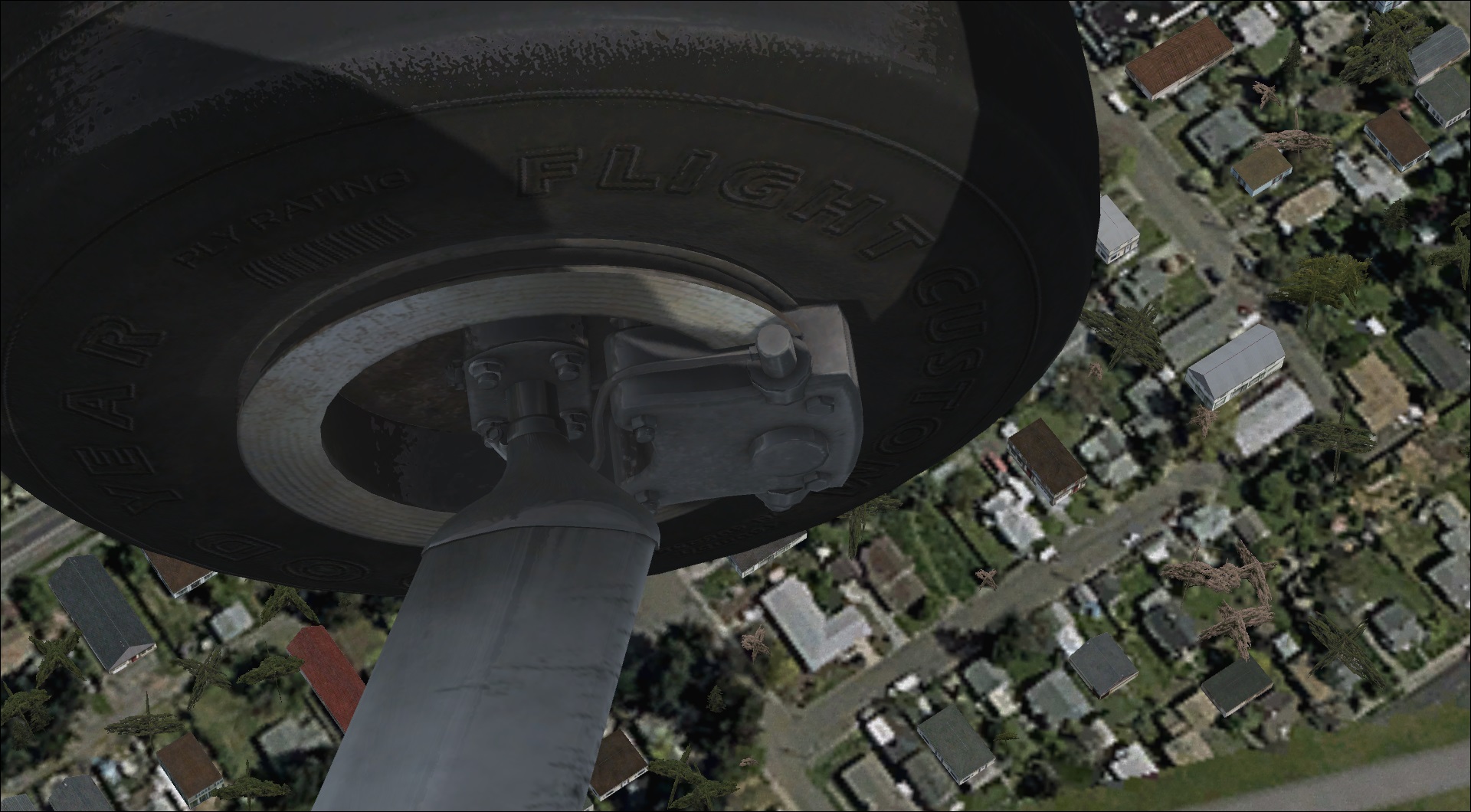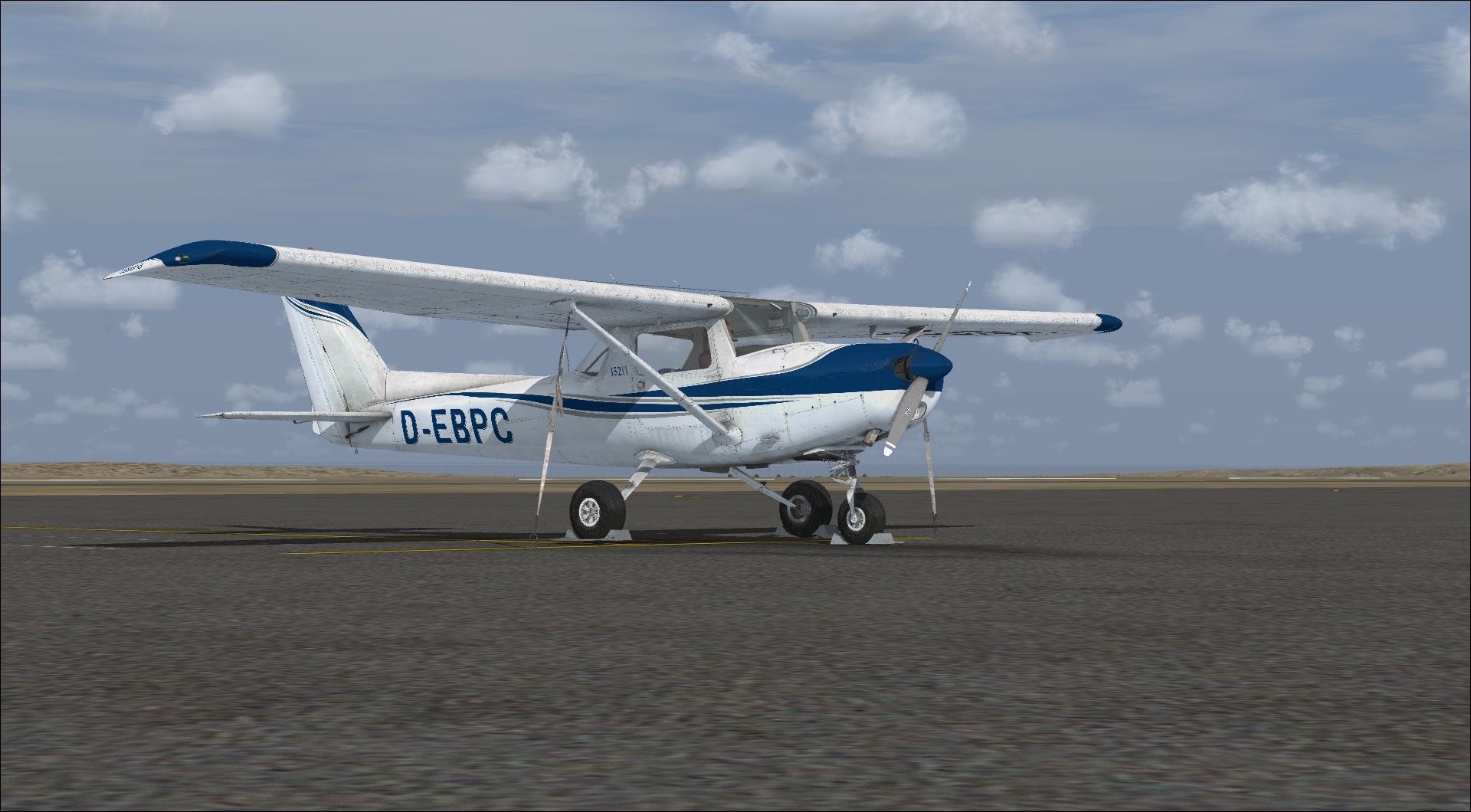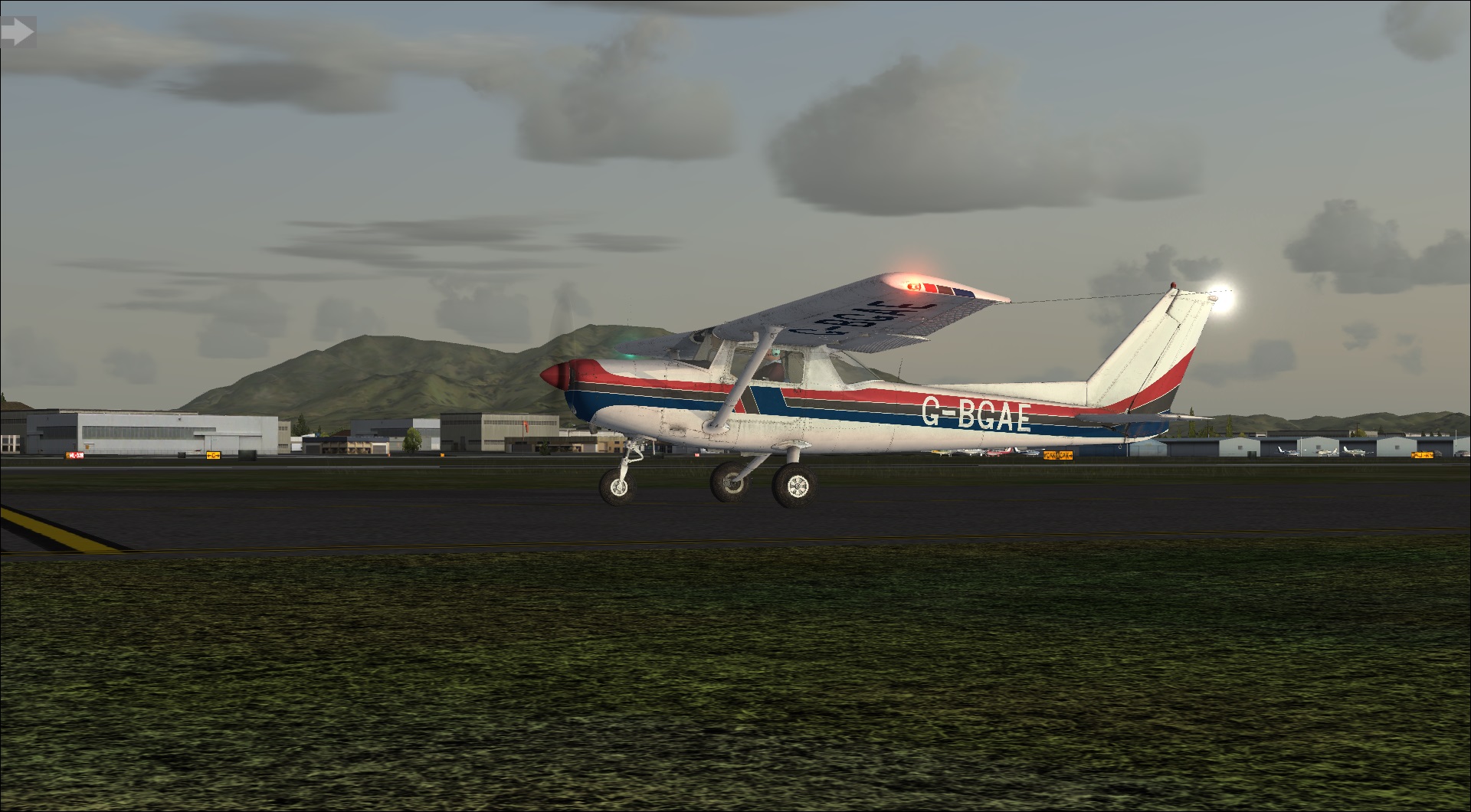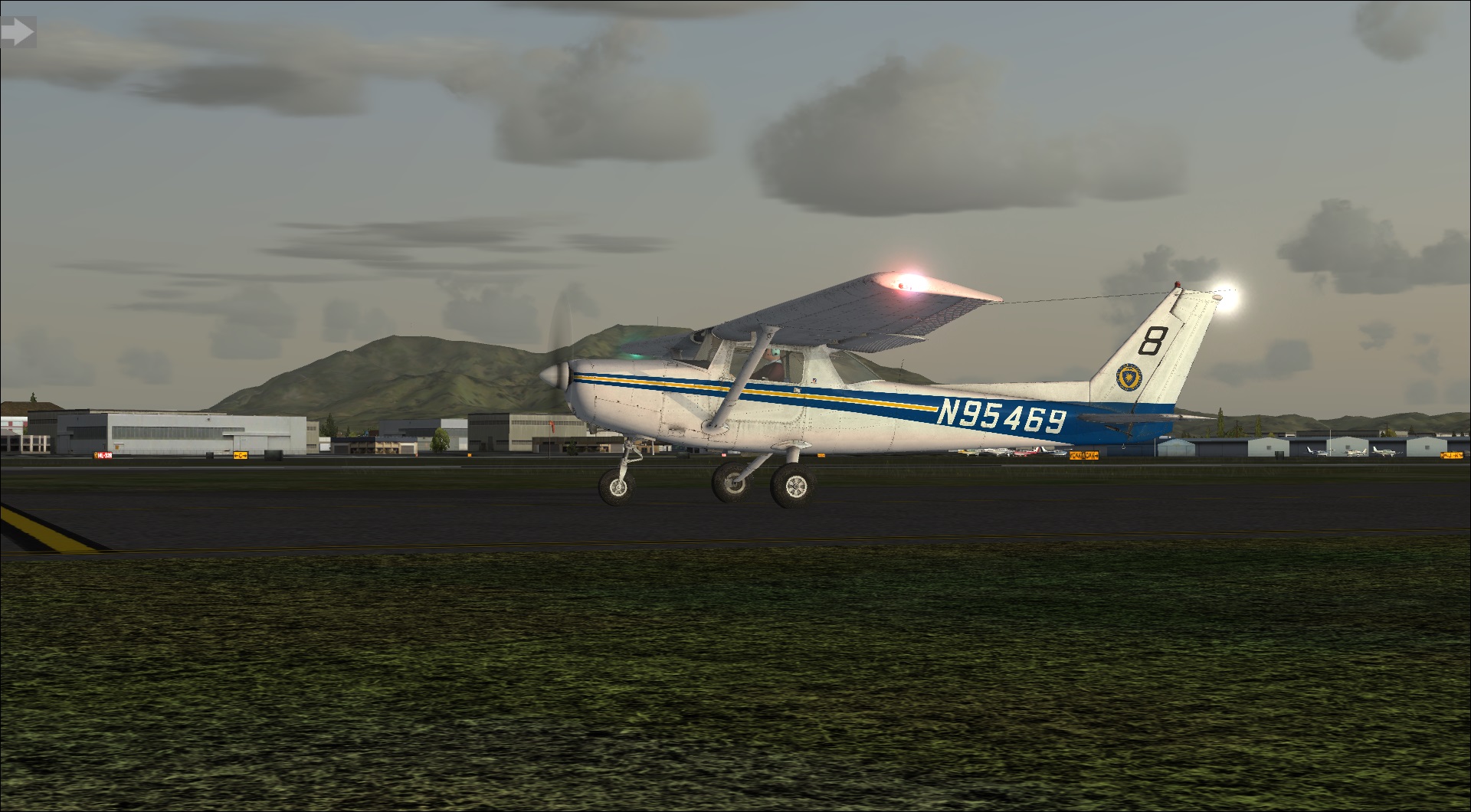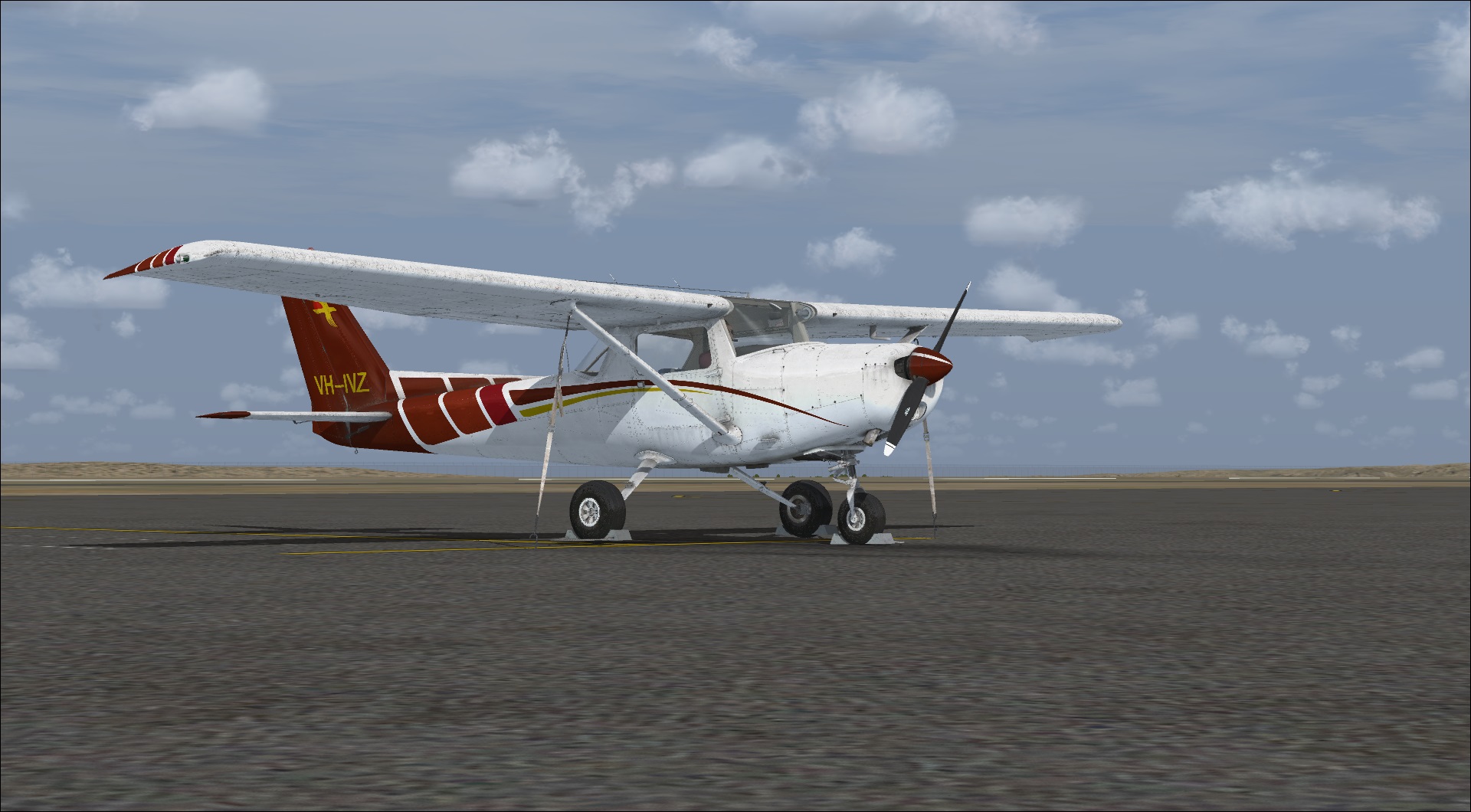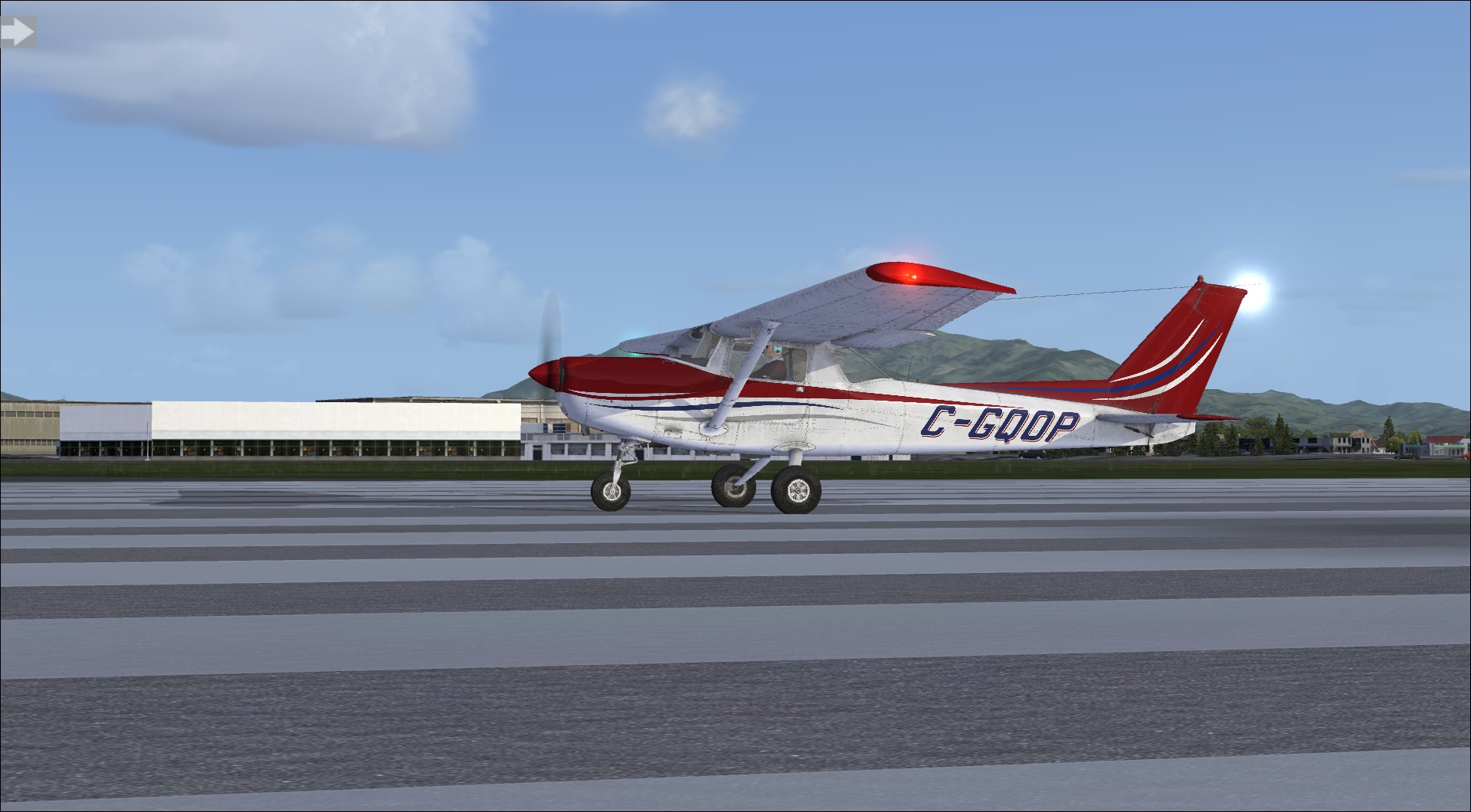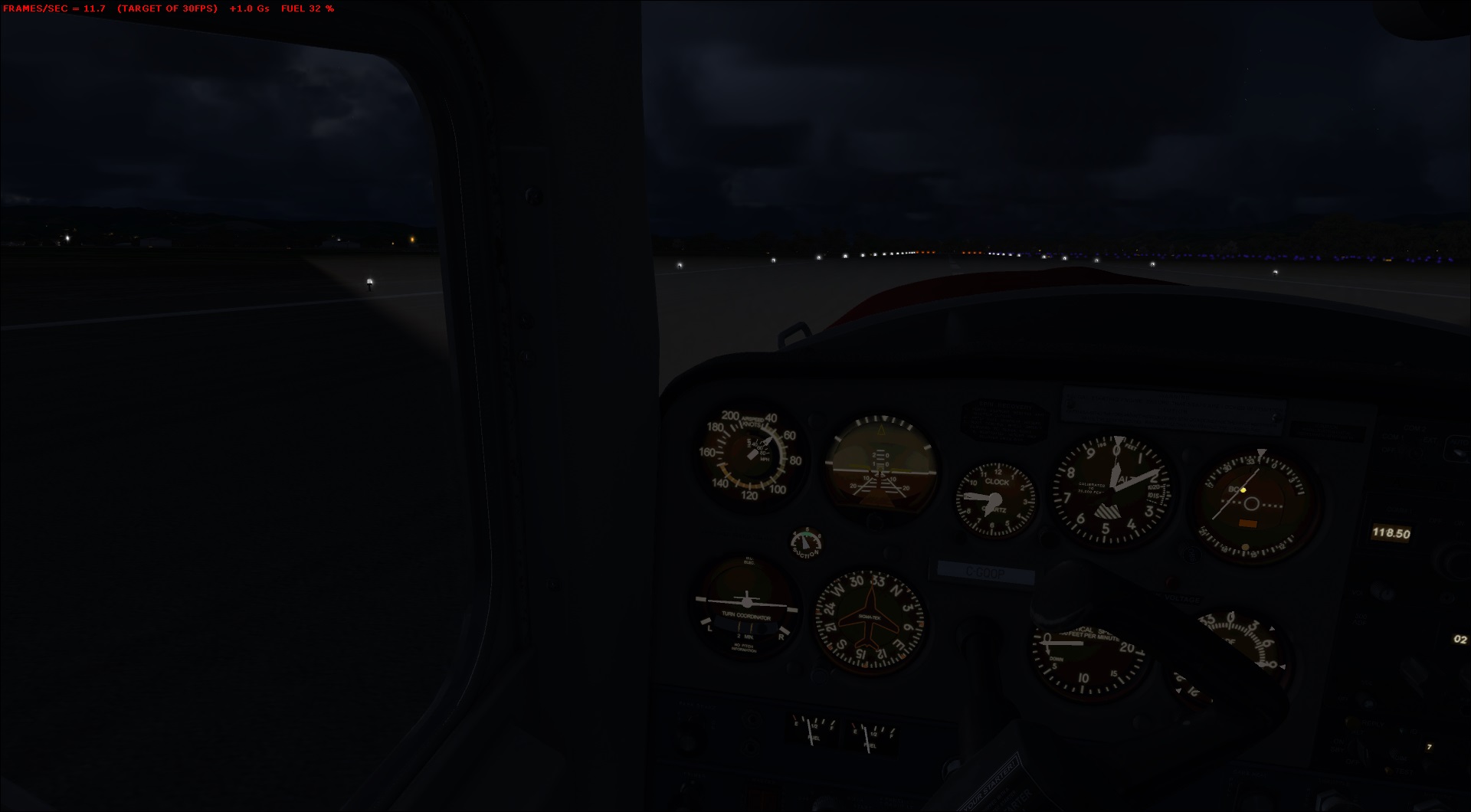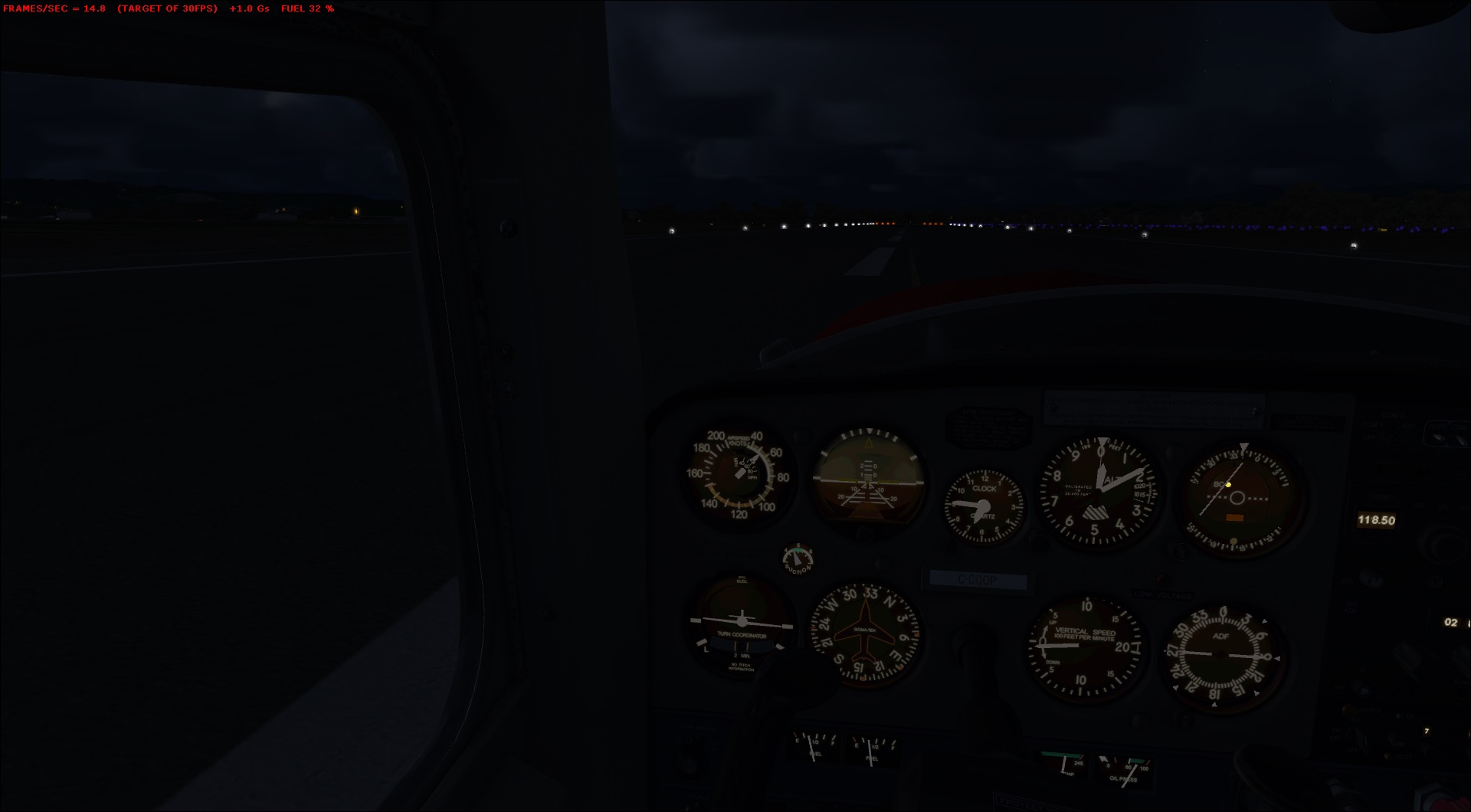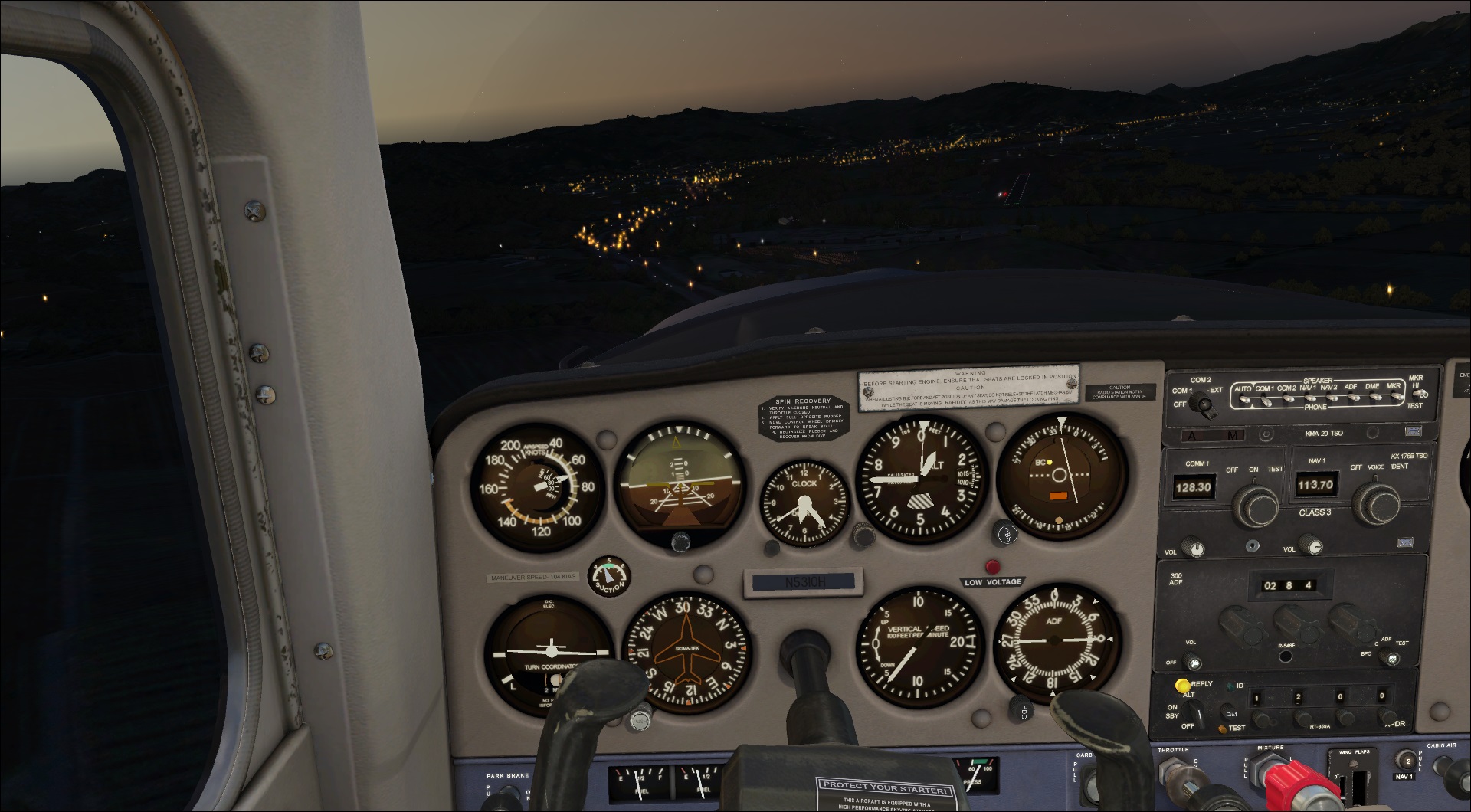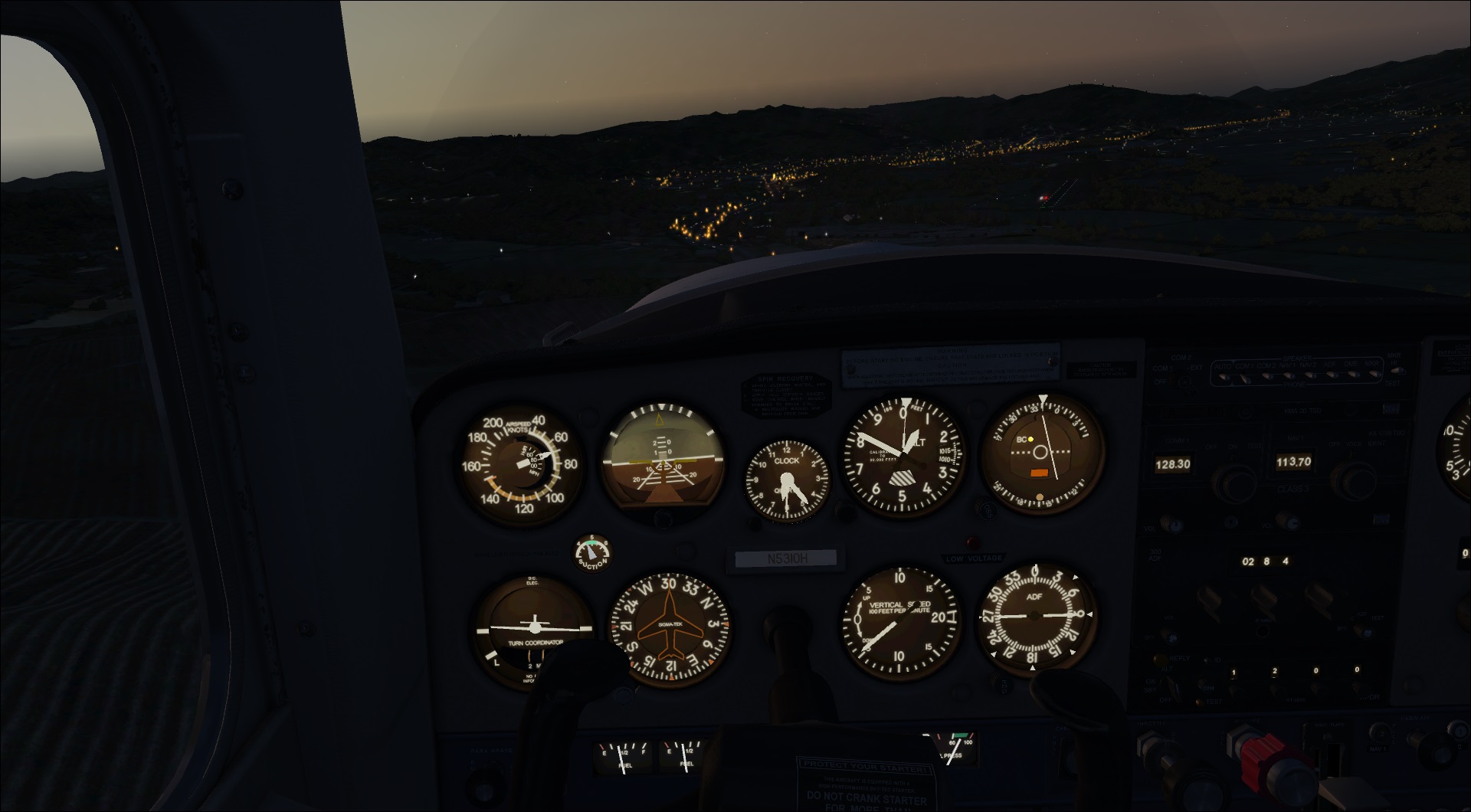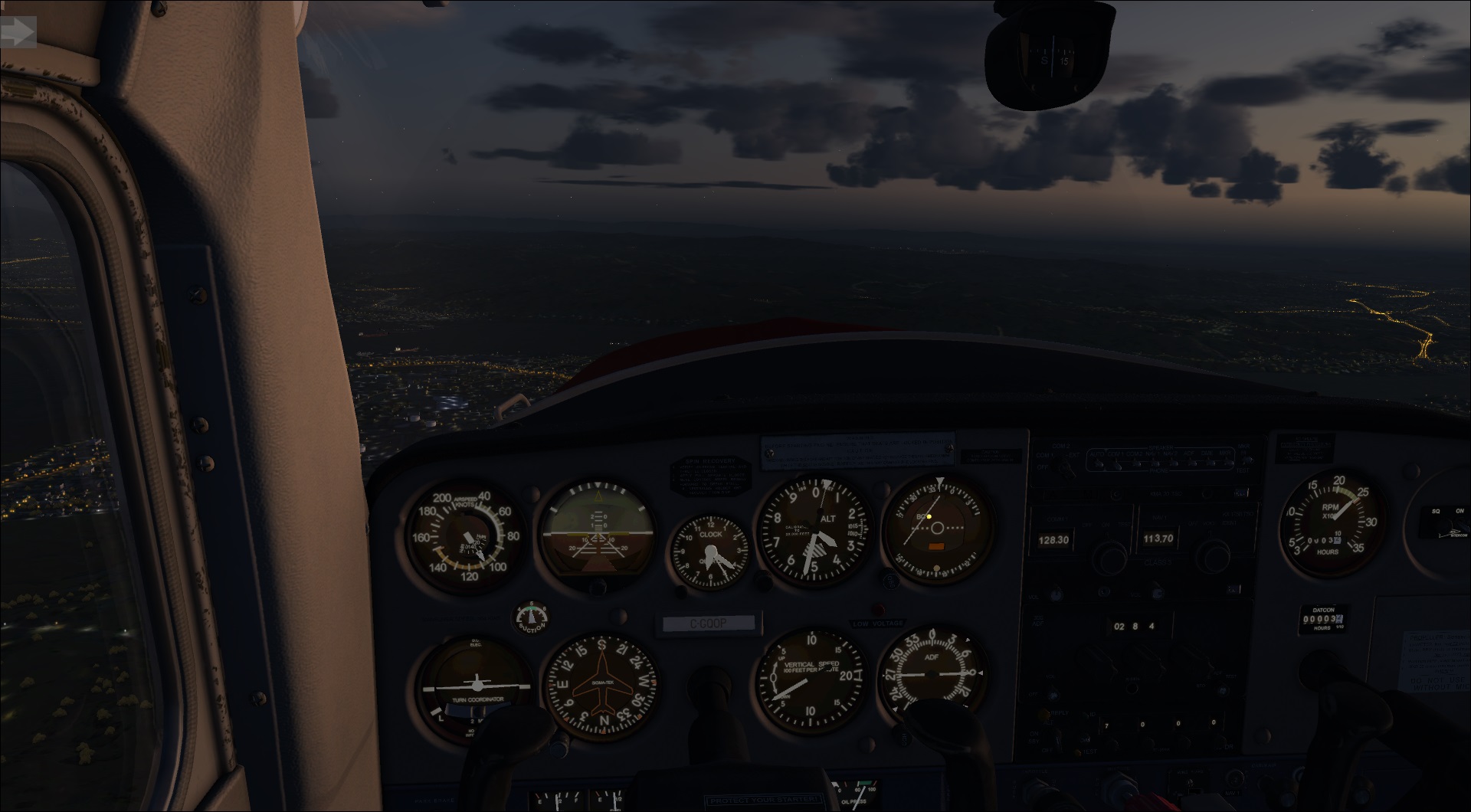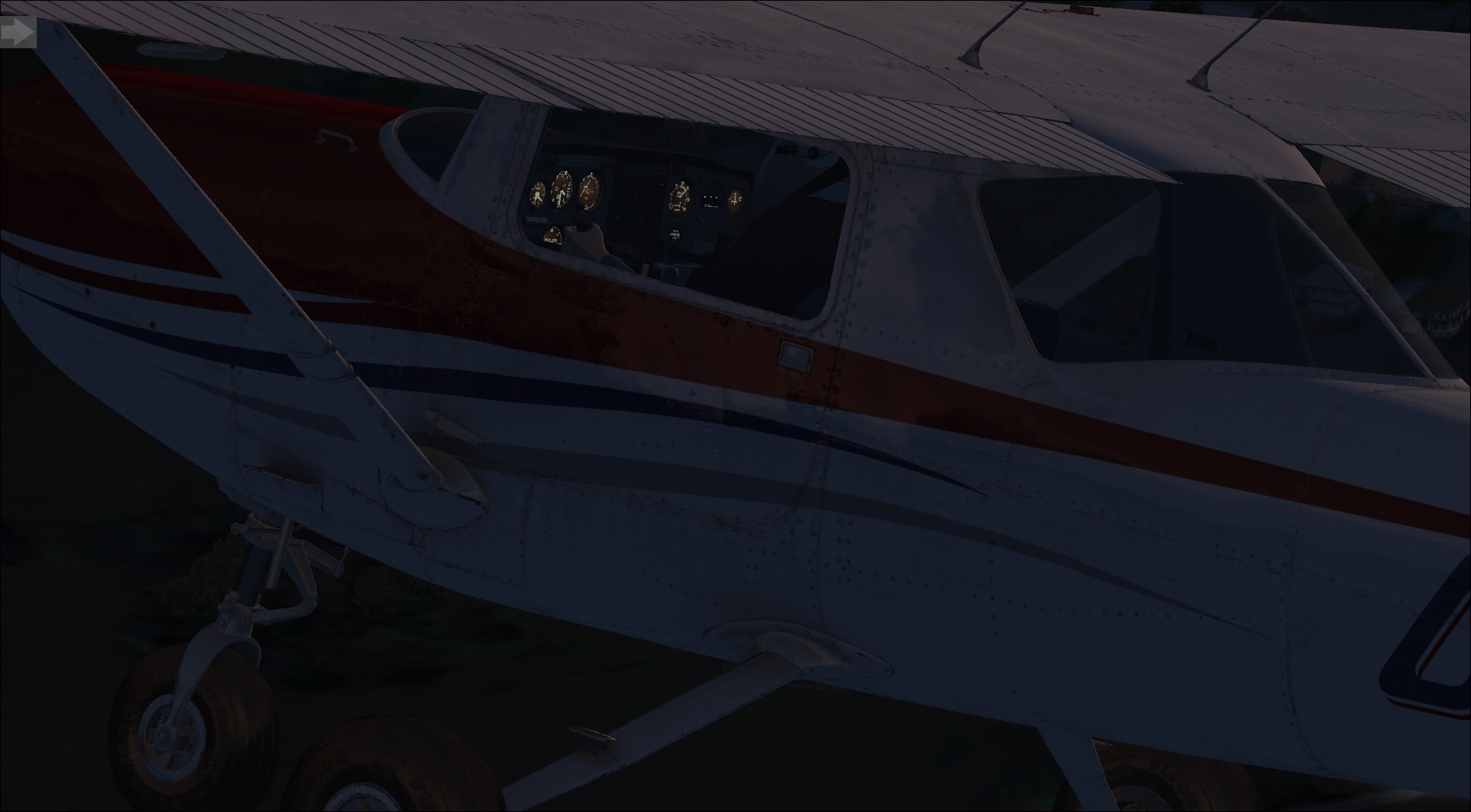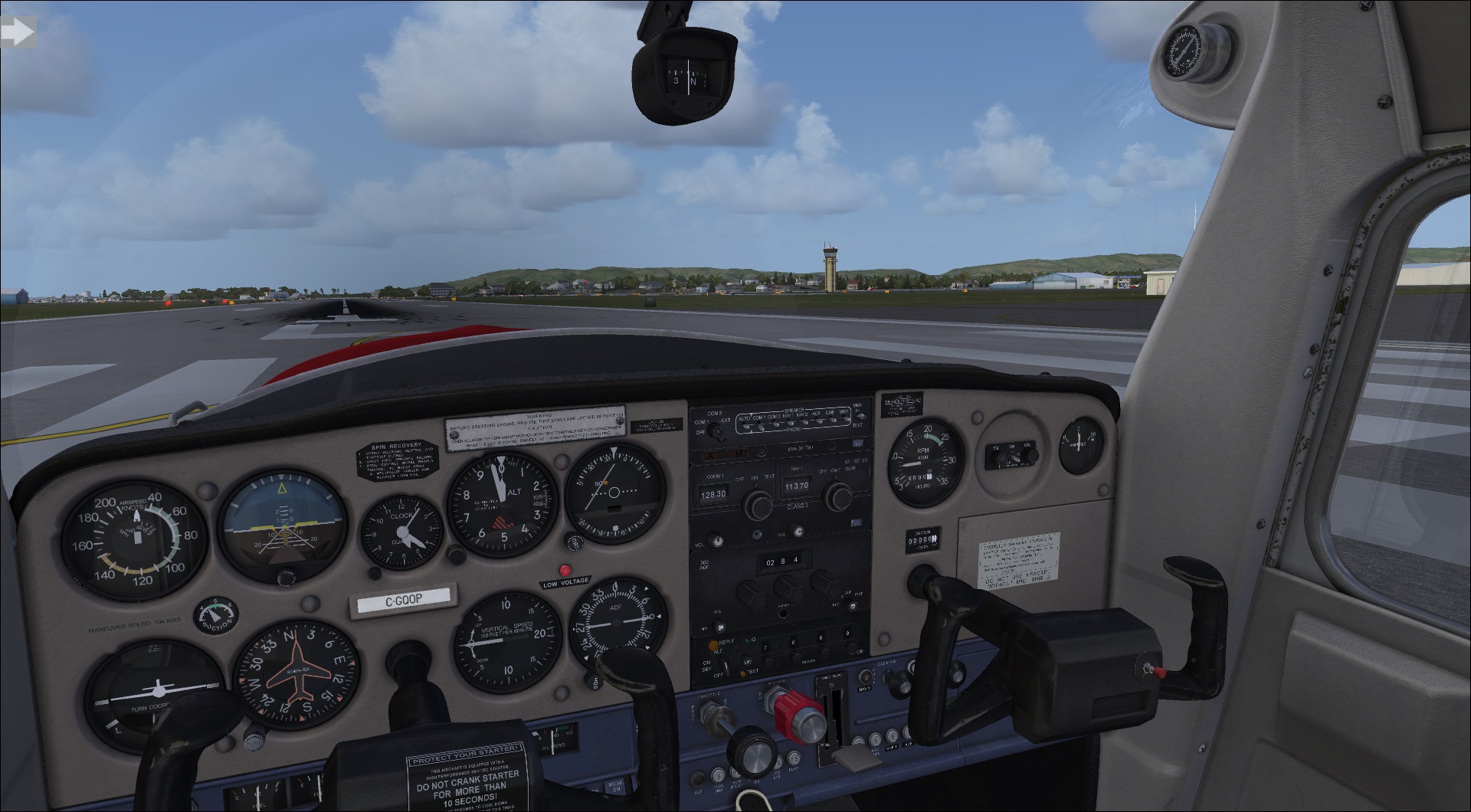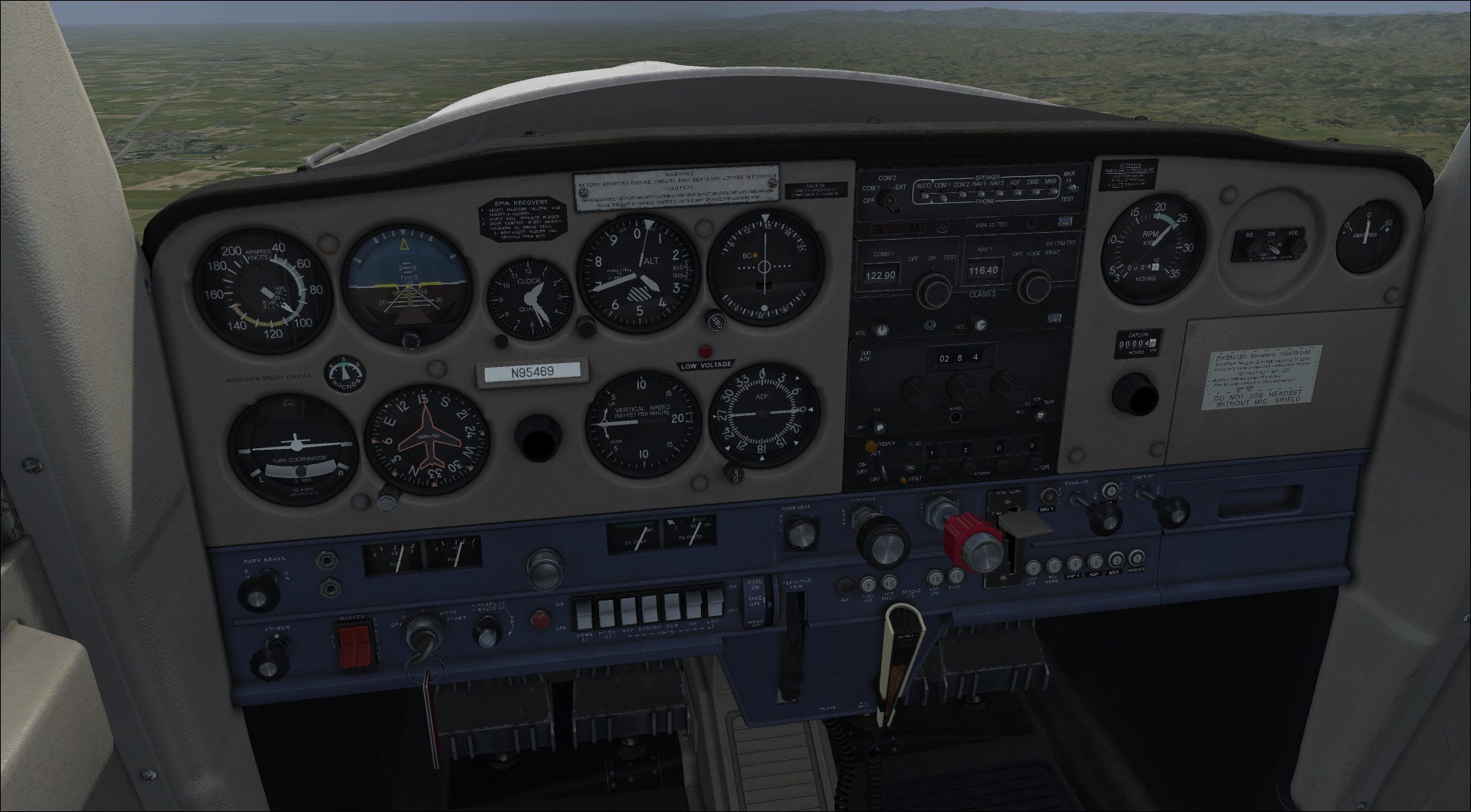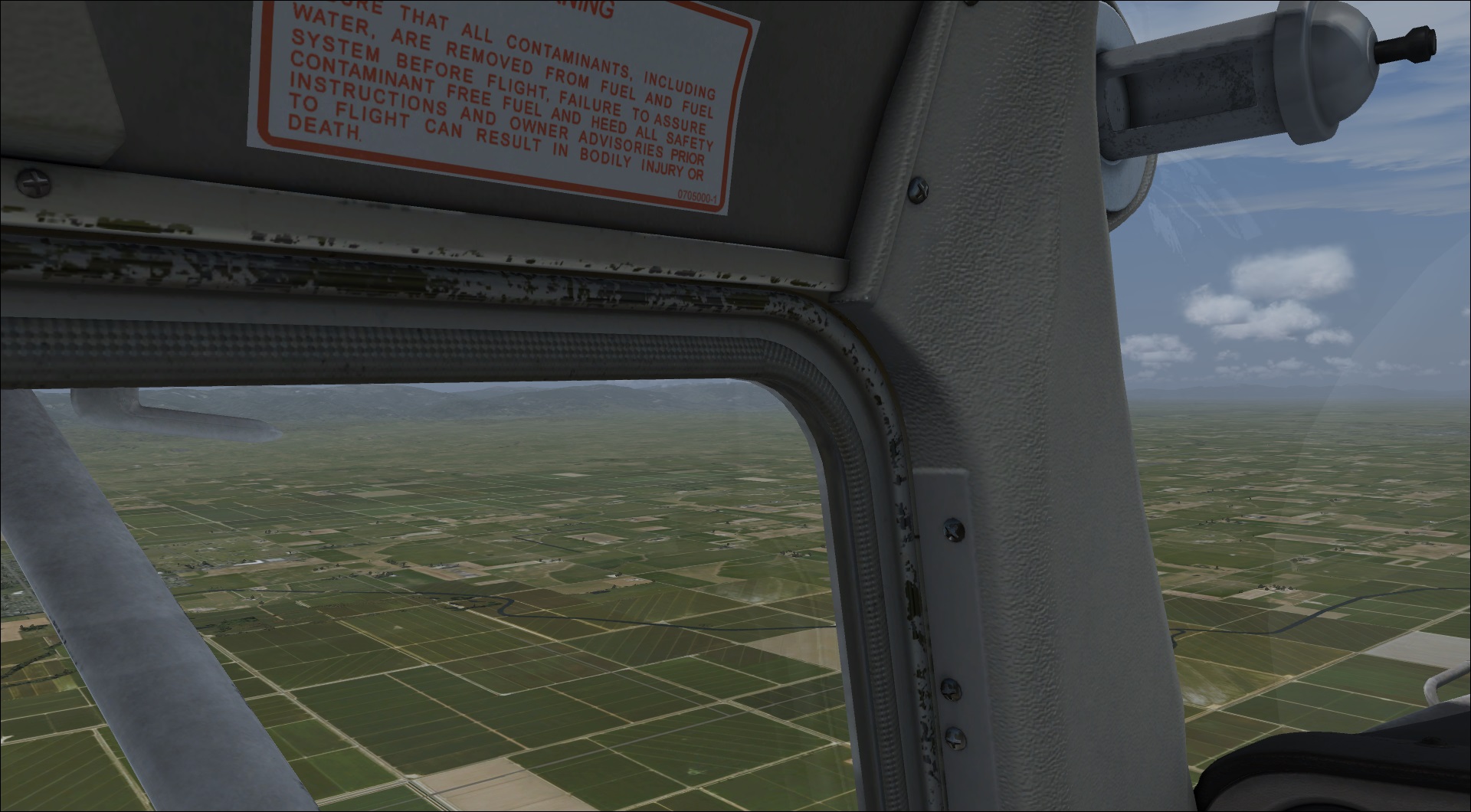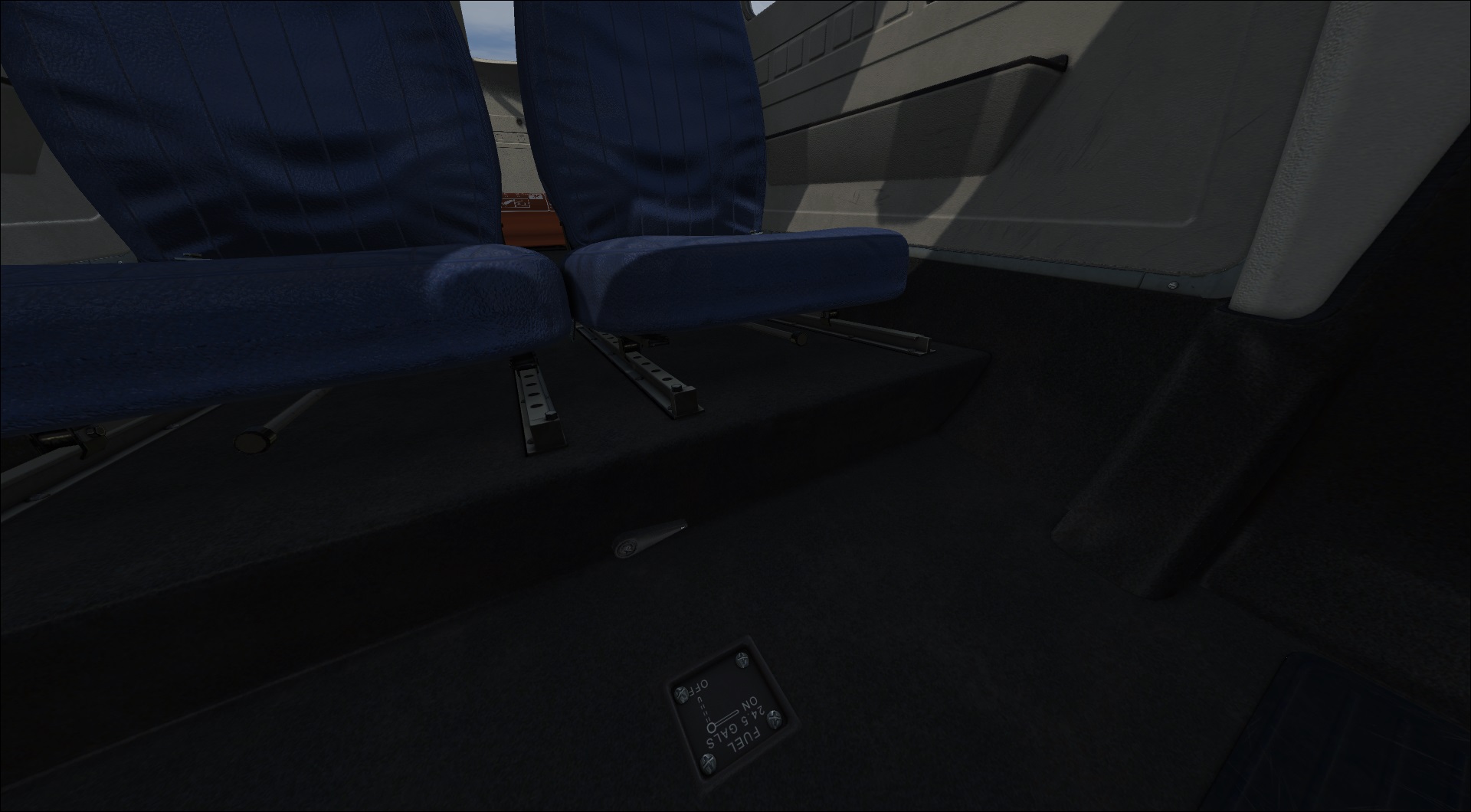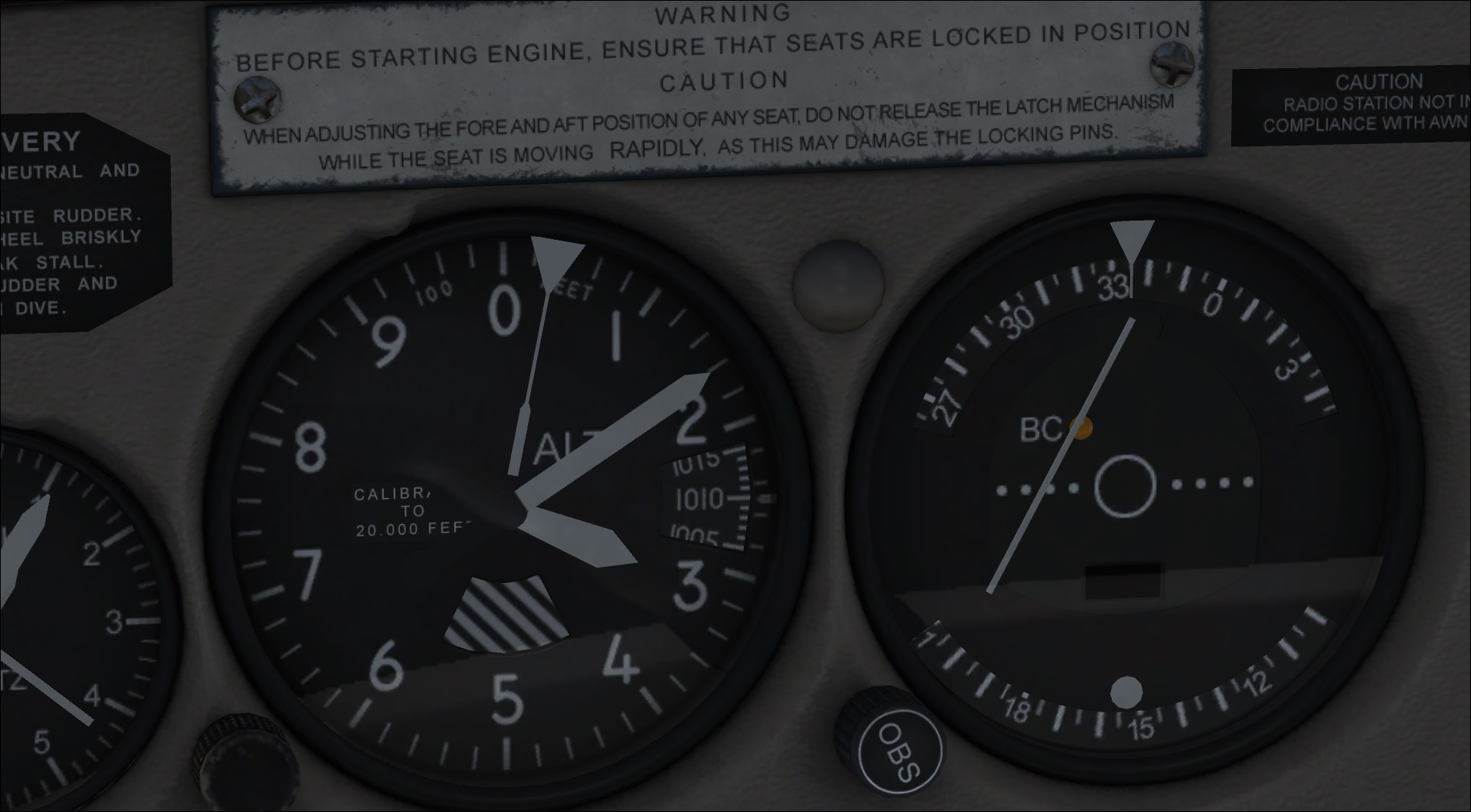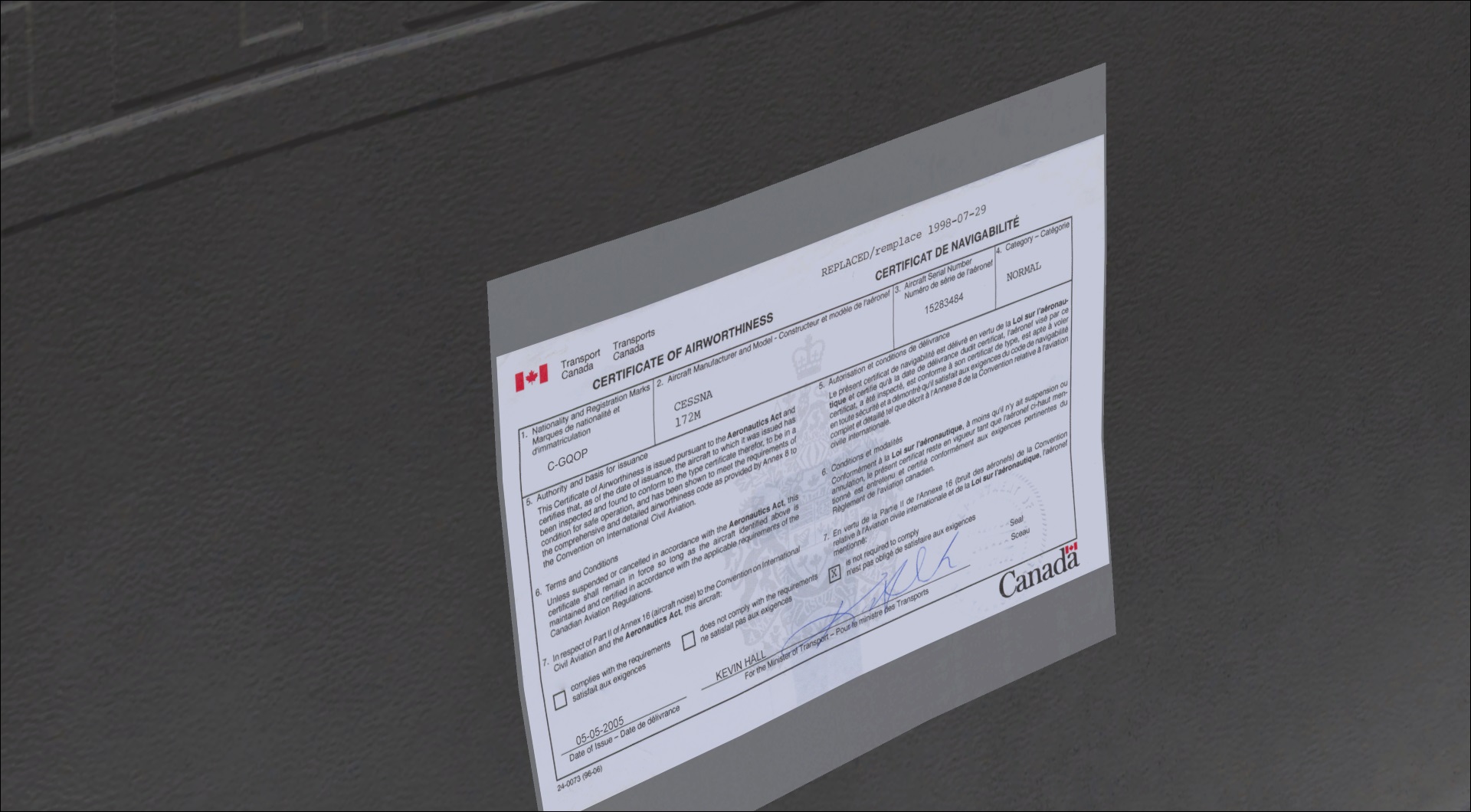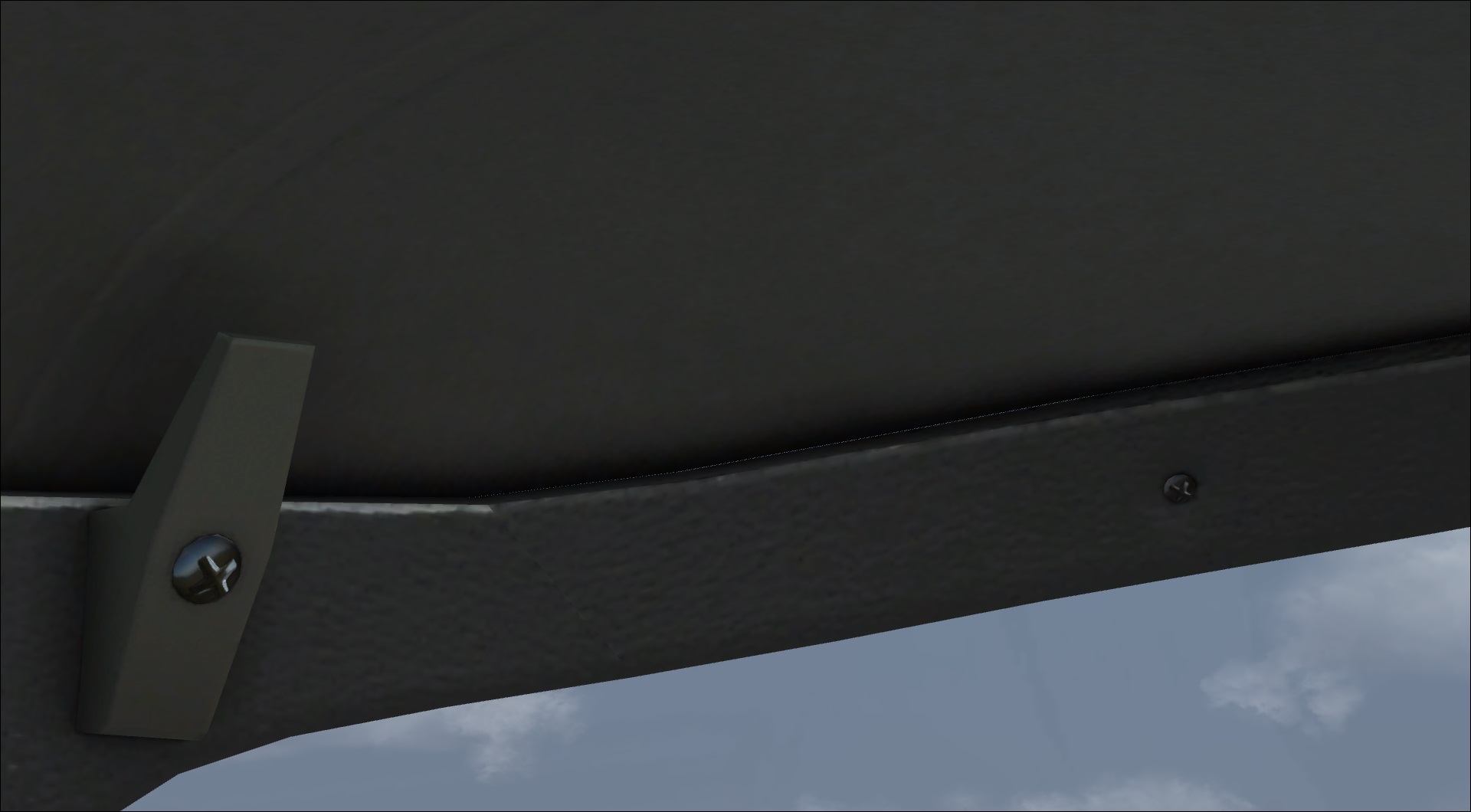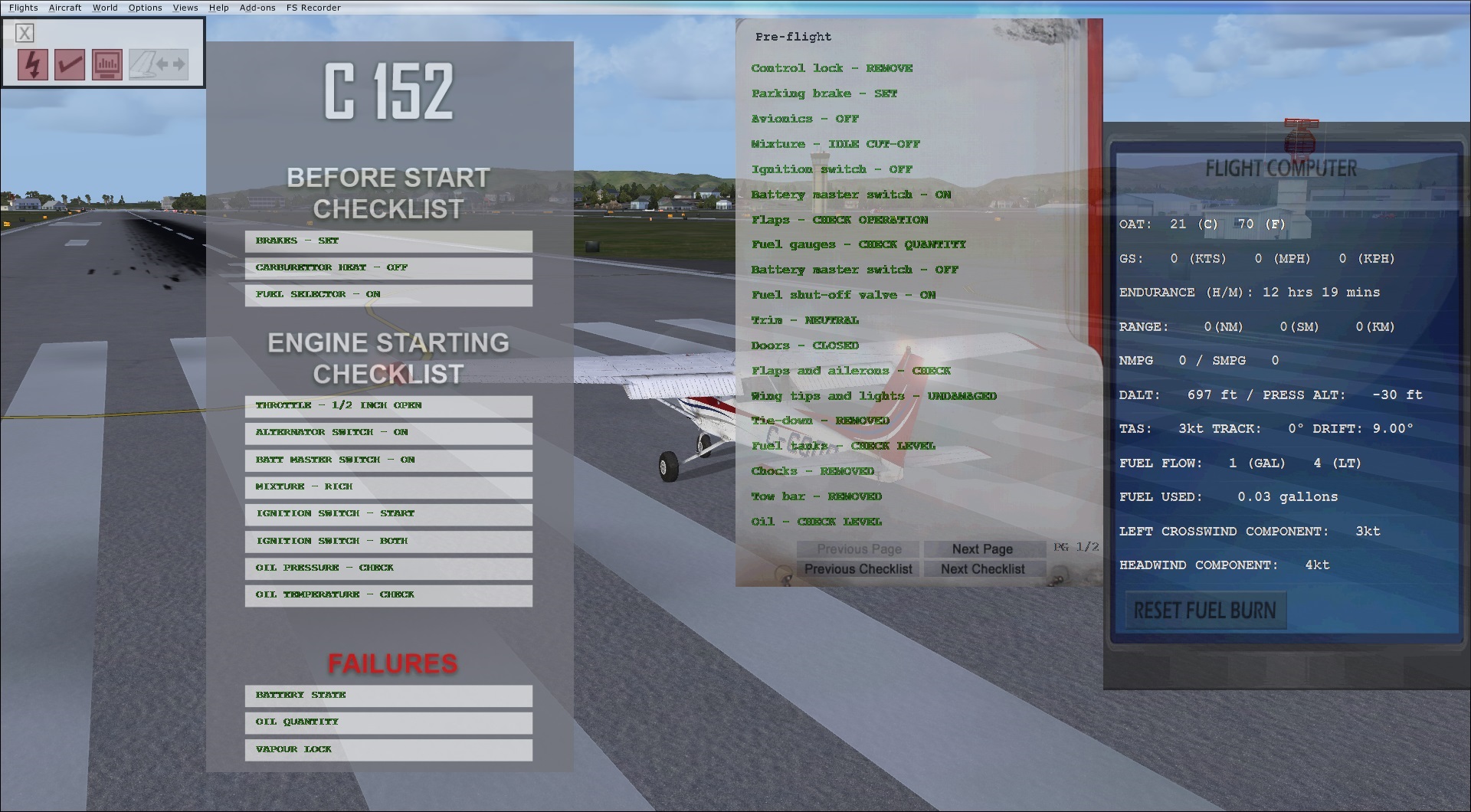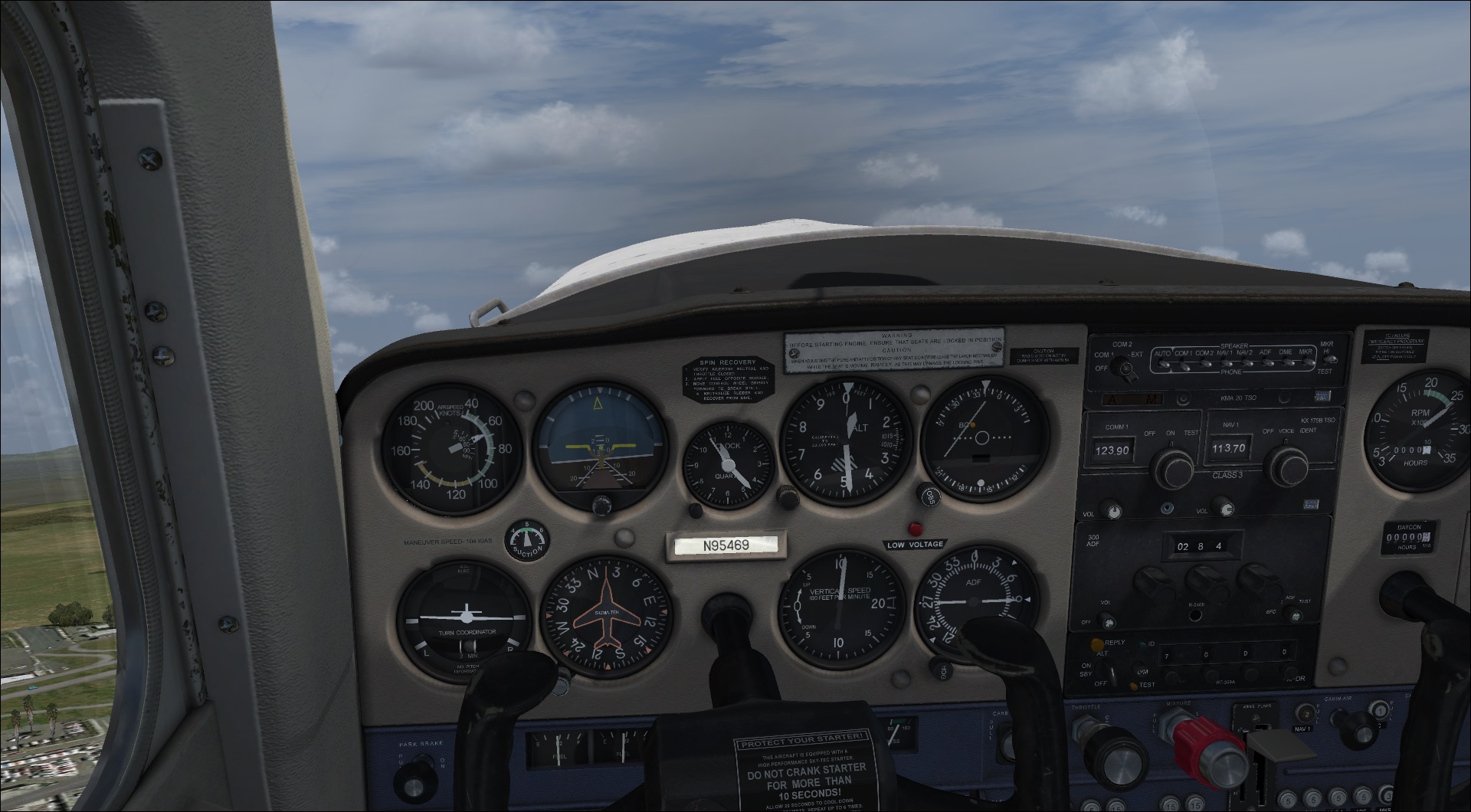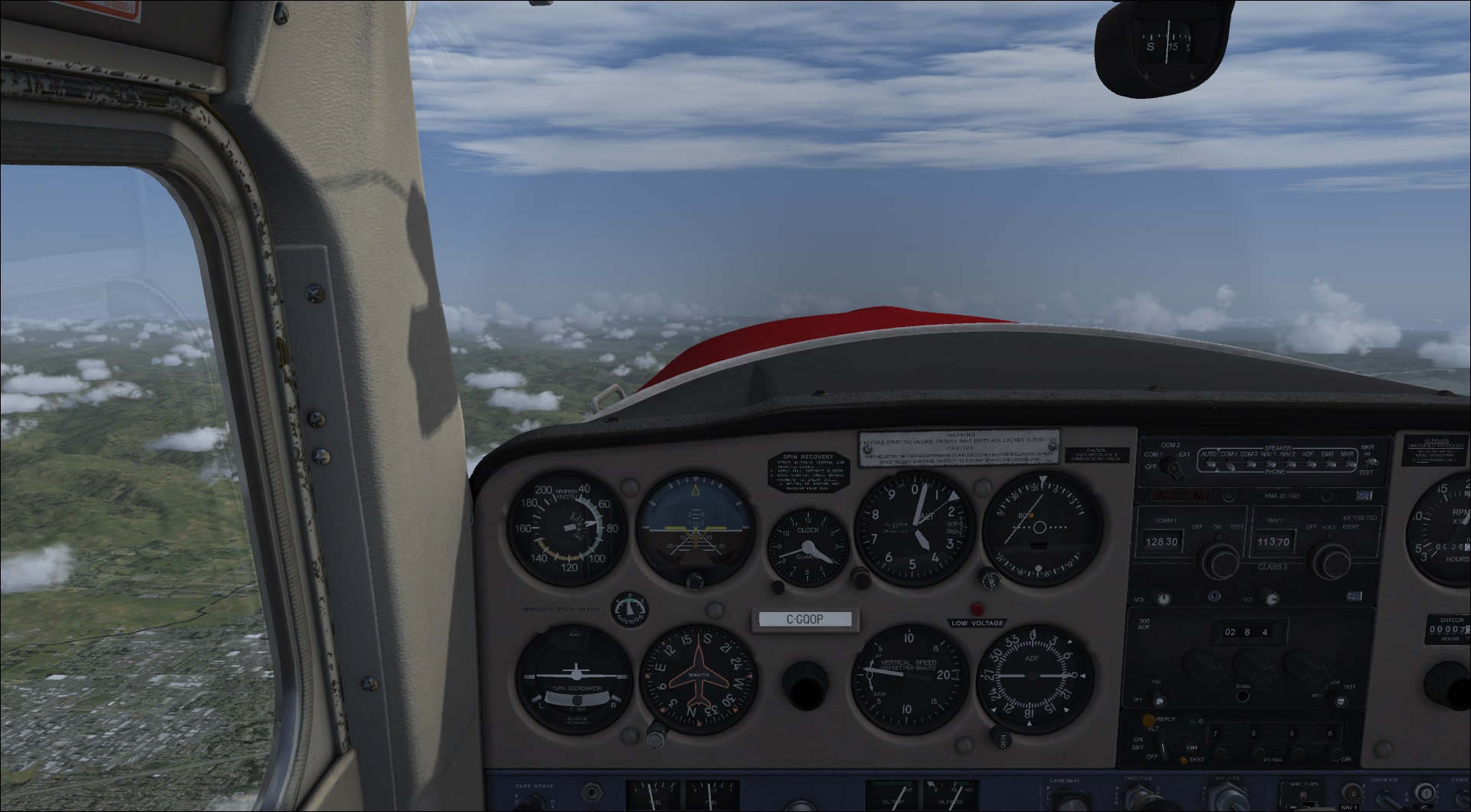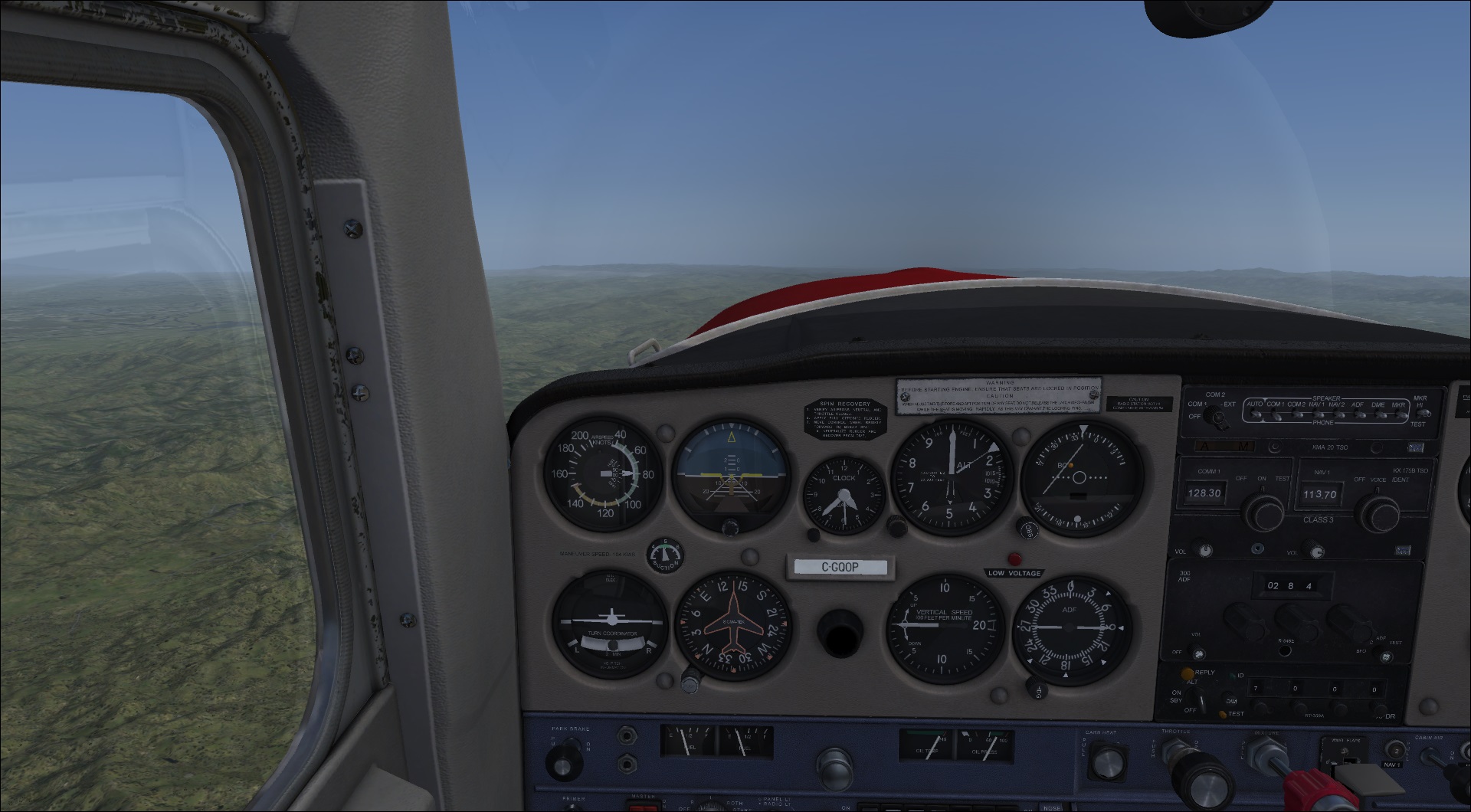Introduction
Welcome to Just Flight's newest release, the iconic two seat trainer and personal general aviation touring bird for the budget minded. The Cessna 152 is an aircraft which probably springs to mind when the term "small aircraft" is mentioned to most people, but the venerable and ubiquitous Cessna 152 is probably parked at most general aviation airports in the world.
Text
First models of the Cessna 152, an upgrade / modernised version of the proven Cessna 150 design were introduced in 1977 for the 1978 model year. The new Cessna 152 delivered improved useful load, decreased noise levels, and was designed to be more efficient at using newly introduced 100LL fuels. Most Cessna 152s were manufactured at the Cessna factory in Wichita, Kansas. Production was also licensed to Reims Aviation in France with these aircraft being designated the F152 or FA152. Cessna 152 production ended in 1985.
Despite being out of production for over 30 years, thousands of Cessna 152s are still flying and being used internationally for student pilot training as well as for personal flying. During the Cessna 152 production run from 1977 to 1985, Cessna and Reims Aviation produced a total of 7,584 aircraft across four variants. With so many aircraft produced and utilised primarily for flight training it is not surprising that the Cessna 152 has more accidents on record than any other single engine, general aviation aircraft. Interestingly, the Cessna 152 holds the distinction of being the only known operational air–to–air kill using an IDAF AGM–114 Hellfire missile fired from an Apache AH–64, after a Lebanese student pilot violated Israel airspace and ignored repeated ATC directions to turn around – note to student pilots, flying and navigation is serious business. Despite its accident statistics, the sheer number of aircraft produced and staggering numbers of hours flown in them, actually make it one of the safest light, single engine, general aviation aircraft from a statistical perspective, and its ruggedness is apparent with so many still in use today. This is all thanks to a simple airframe, reliable engine, and robust construction intended to be used by student pilots. Its design and manufacture has obviously withstood the real world test of time so how will Just Flight's virtual reproduction of this iconic training aircraft fair in this virtual world review? Read on and find out.
Availability and Installation
The Just Flight Cessna 152 is currently available direct from Just Flight and Just Flight resellers as a download only product (some resellers also offer a master back–up CD / DVD service for a minor additional cost). It is normally priced at £27.99, or the equivalent on currency cross rates. The download file size is 671MB and it requires 2GB of HDD/SSD space for installation.
You are required to log in to your Just Flight account during installation to verify your purchase. Other than that, the trusty Just Flight installer for the Cessna 152 functions similar to all their products. It is straightforward and intuitive, but note that it is recommended that you should disable your active anti virus protection during installation to avoid any errors during installation. The Cessna 152 installs automatically to your aircraft folder, and a manual is placed into a Cessna 152 file folder in your Just Flight folder under the main flight simulator folder. A tutorial flight is also provided and new pilots may wish to follow along with this tutorial flight as described in the manual.
Model Features
The major model features of the Cessna 152 include:
accurately modelled using official real world aircraft plans;custom coded electrical system with functional circuit breakers for isolating instruments and systems;
functioning carburettor heat and primer controls, including primer simulation for cold weather operations;
failures, including spark plug fouling, limited battery life, vapour lock, and more;
refill menu for quick and easy refilling of fuel and oil and recharging of the battery;
highly detailed cockpits with 3D instruments with authentic fuel and RPM gauge needle wobble;
comprehensive IFR capable avionics fit;
authentic labelling and placards based on those found in the real aircraft;
custom sounds for switches, doors, primer control, wind noise, and more;
comprehensive manual with panel guide and performance data;
numerous animations, including passenger doors, cockpit windows, sun visors, map compartment, and engine exhaust, and ground equipment, including chocks and tie–downs;
instrument and radio lighting can be dimmed and is separately controllable to the dome lighting;
cockpit textures feature wear and tear based on reference photos taken in the real aircraft to produce an authentic environment;
interactive checklists for every stage of flight;
panel state system which will automatically save the panel state whenever a flight is saved and reload the panel state whenever that flight is loaded;
flight computer panel with useful information such as fuel burn, endurance, speed, and wind speed/direction;
Flight1 GTN and GNS integration in the virtual cockpit;
functional control lock and removable ignition key for an immersive start–up experience;
authentic sound set; and
realistic and accurate flight dynamics.
There is also a tow bar to help push the aircraft into your favourite hangar or tight parking space on the ramp. It takes a bit of getting used to but has certainly more control than the default push back key provides. As it is a simple Cessna 152, if you are already an accomplished pilot, hopping into this basic bird and scanning the panel is pretty much all you need to do to figure out how to start her up. On the other hand, as the Just Flight Cessna 152 also caters to casual flight simulator pilots, using Ctrl–E or selecting Ready to Fly state from the panel selector will get her purring swiftly. Either way, the aircraft is a very in depth simulation of a very easy to fly aircraft.
External Visuals
External views are impressive. Textures are provided in 4K quality, although most of my review screenshots were taken using 2K max textures due to my system limitations, but I honestly could not see much difference between the 2K and 4K textures unless zoomed right up close. Even so, details such as rivets, struts, hoses, and lines are well modelled and hold up even under very close magnification / zoom levels. The airframes are scuffed up with paint chips and dirty filth deep in the nooks and crannies. Obviously folks have been merely throwing damp sponges at these aircraft come bath time for many many years, consistent with hard use, training school aircraft. All models have this level of grunge, however, I would have liked to have seen a freshly painted or washed version or two – not all of us would deign to fly, let alone claim ownership of such a dirty bird. Since Just Flight include a paint kit I suspect livery artists will be soon providing custom liveries using the provided tools, and we will soon have access to fresh, clean birds in short order. However, I was disappointed not just in the lack of a clean model, but also in the lack of a nice private touring model, with wheel pants, speed modifications, and pristine paint job – that pretty Cessna 152 that someone has babied for all these decades in a spotless hangar. That bird is not in this package, however, the rendering of this filthy aircraft is quite stunning.
Models and liveries
The Cessna 152 is provided in a single model with eight individual liveries (a selection showing below).
Lighting
The navigation lights, beacon, and landing light all look properly placed and appropriately bright except for the white tail recognition light which to me seems quite a bit too bright, a large ball of white sitting on the tail even in bright daylight.
A serious exterior lighting issue noted was that the landing light does not illuminate the ground once the tyres touch down, and as the taxi light seems to be in the same fixture it has the odd characteristic of not working until the landing light is shut off. The taxi light will not provide illumination while the landing light is on, and the landing light does not shine any light on the runway the second the aircraft touches down requiring one to instantly turn off the landing light once wheels touch or there will be zero ground illumination – surely not a real world feature of the Cessna 152 landing / taxi light functionality.
Interior lighting is mostly well done with adjustable instrument and radio stack lighting levels using rotary dials, both on the same knob. Regrettably, the dome light is only visible on the panel at night, and has one level, which is too bright to use at night but is necessary to see switch labels well on the otherwise dark panel surface, but which would, in reality, rob external night vision if used. I would like to see a red bulb in the dome rather than the white bulb provided, a variable intensity dome white light, or even better, a selector to swap between white or red dome light, but I suspect that the Cessna 152, in reality, might not have much in the way of night time navigation illumination on many models in the real world, so this may be accurate. Also noteworthy is the external view of the interior panel matches exactly the VC view from inside for both illumination and instrumentation.
Virtual Cockpit Details
My initial impression once in the cockpit of the Just Flight Cessna 152 was, WOW, such visually stunning detail.
The Cessna 152 has a cabin layout of two passenger seats forward and a generously sized cargo area behind, large enough for an accessory extra seat (not modelled) or a large piece of cargo or stack of bags. The plastic panelling is very well textured, contoured, and all screw heads are modelled. Every placard and information panel is easily readable and crisp even at high magnification and every livery comes with its own unique airworthiness certificate in the rear compartment.
Every circuit breaker and switch is modelled and functional. Pulling a circuit breaker for a system deactivates that system with an appropriate soft click – lovely. Switches have click sounds appropriate to their size and type. Most knobs are variable, but some volume knobs on radios are all or nothing, when clicked they rotate all the way on or off respectively. Switches and knobs use different variations of right or left click or mouse wheel control and take a bit of getting used to which is which. The cockpit has a well worn, very used look to it, as one would expect from an aircraft as old as 30 years more that has probably been used for decades extensively as a trainer by countless ham fisted nervous student pilots, i.e. grungy but well maintained overall, but again, no pristine model version. Panels are in decent shape and instruments have wear in appropriate high spots and near knobs. Except those seat covers! Despite the exterior colour scheme, every interior has the identical seat upholstery and carpet colour. It is not a major deal but at the price point of the model, at least one person (the guy with two thumbs writing this review) expects some interior variation as well. Also, since the glove box door opens, I would also liked to have seen something in that empty glove box (perhaps a link to open checklists or maps graphically represented as a checklist and a map, or something useful like that), because opening a door to find nothing inside is just an empty gesture (cough, cough). Also noted were occasional gaps in the interior at 3D seams / cuts, allowing external flickering to occur between the cuts. Some have been fixed already, including a glaring one at the bottom of the passenger door, some minor "wigglers" as I call them are still visible above the front windows. The gaps are so tiny that they would not be noticeable except for the fact that the varying terrain, sky, and clouds behind the gaps "twinkle" as the background passes behind the gaps.
If you have payware add-on GPS units like the Flight 1 GTN 650/750 or GNS 430/530 installed in your simulator, you can use those in the Just Flight Cessna 152 cockpit to replace the default radio stack. I do not have any of these so can not review that integration, but suspect there are no issues as I have noted no comments on the Just Flight Forum regarding it. There are multi page interactive checklists available as 2D pop up panels to help the pilot start the aircraft up using correct procedures and they are well designed and intuitive to use.
Sounds
The sounds complement the simulation's immersion effect and are convincing and rich. Engine noises vary organically and do not noticeably loop. Flaps are electrical and make convincing motor / actuator noises while deploying and retracting. External sounds are quite nice as well, varying as I pan around the aircraft, especially noticeable while passing the plane of the propeller – neat stuff.
General Characteristics and Performance Specifications
The general characteristics and performance specifications for the Cessna 152 are provided in the table. This is based on data from the official Cessna 152 Pilot Operating Handbook, data provided by Just Flight, and general research sources. Some of this data varies between sources and also may be an approximation due to variances in data and the specific aircraft modelled by Just Flight.
General Characteristics
| Crew | One |
| Passenger Capacity | One |
| Length | 24 ft 1 in (7.3 m) |
| Wingspan | 33 ft 4 in (10.2 m) |
| Height | 8 ft 6 in (2.6 m) |
| Empty Weight | 1,081 lb (490 kg) |
| Fuel Capacity | 26 US gal (98.4 l) |
| Maximum Take-Off Weight (MTOW) | 1,670 lb (757 kg) |
| Power Plant | 1 x Lycoming O-235-L2C, four cylinder, horizontally opposed, piston engine, 110 hp (82 kW) |
Performance Specifications
| Maximum Speed | 110 kts (126 mph, 204 km/h) |
| Cruise Speed | 107 kts (123 mph, 198 km/h) |
| Stall Speed | 43 kts (49 mph, 79 km/h) full flaps, engine at idle |
| Range | 414 nm (477 mi, 768 km) |
| Service Ceiling | 14,700 ft (4,480 m) |
| Rate of Climb | 715 ft/min (218 m/min) |
Flight Performance
Once started up and cleared to taxi, ground handling is easy and nimble in a lightly laden aircraft, but becomes more slow to respond when loaded up, as expected. Unladen it will begin rolling on asphalt at around 1,000 to 1,200 RPM, maximum loads will require 1,300 RPM or more. This is something which has been adjusted in updates in response to forum comments by real world Cessna 152 pilots. These updates were occurring whilst I was doing this review and may still be in a process of adjustment. Steering is by nose wheel and can be assisted with somewhat soft feeling (i.e. they don't jerk the aircraft around much, and seem well calibrated) but effective toe brakes. A quick burst of the throttle will blast air over the turned rudder and help sharpen a taxi turn as well – very well done. Pilot and passenger windows open for airflow and once over 20 kts ground speed some wind noise cuts in abruptly. If possible, I would have preferred a more gradual increase but regardless, it sounds like airflow through an open window should. However, I did not note any changes due to crosswind effects while taxiing, the sound remains consistent at any heading and speed while taxiing.
Researching performance data for the Cessna 152 revealed many sources but most agree within a range of values. I adopted some real world expected values from an online Cessna 152 club site which lists figures slightly and sometimes very much less optimistic than published manufacturer values. Take off in a mild cross wind with max weight and fuel on board was straightforward and stable, with initial rotation at 55 KIAS, it left ground at 60 KIAS, and with speed set at 65 KIAS, I maintained a rate of climb of approximately 700 ft/min, consistent with real world published specifications. Cessna 152 club site comments noted a more nimble rate of climb of 800 to 1000 ft/min when the aircraft is lightly loaded.
The aircraft begins requiring mixture adjustments at about 3,500 ft, and climb rates begin to suffer after then. Published specifications note the service ceiling for the Cessna 152 may vary between 12,650 ft to a high of 15,300 ft, but I doubt one would want to force this bird up to either of those heights, let alone carry the extra weight of oxygen bottles and masks to fly up there. Rated for daytime VFR it is a pretty basic little trainer / budget touring bird with expected budget performance. Most Cessna 152 flying occurs between 2,500 and 6,500 feet and rarely above 9,500 ft, as per the Cessna 152 club site wisdom. Performance and climb rates in the simulation match those values, and I would not want to waste the virtual fuel and real time trying to climb much above 6,500 ft unless I had to avoid hitting a mountain range in my way, as performance drops precipitously at higher altitudes. Nevertheless, this is virtual science so an altitude test was performed to see if this simulation could make it up to 15,000 ft, and how performance was affected along the way. In short, yes, it can make it to 15,000 ft, but only at 100 ft/min once past 14,000 ft, and it took almost half the fuel in the tanks to get up there.
Establishing a test of performance altitude beginning at 2,500 ft, a speed of 100 KIAS was maintained at 2,450 RPM, and with a fuel burn rate of 8+ gal/hr. This was at a power setting of 100%. At 85% power IAS dropped to around 95 kts and fuel flow reduced to 7 gal/hr which was well within published and club real world data. I did power setting and speed tests every 500 ft up to 6,000 ft with diminishing performance and range the higher I went, thus giving credence to the club values of 3,500 ft being an average Cessna 152 cruising altitude. Best speed and range while loaded to MTOW during this test was at 3,000 ft, achieving 102 KIAS at 9 gal/hr at 100% power, 92 KIAS at 7 gal/hr at 85% power, and 82 KIAS at 6 gal/hr at 75% power. Another series of test flights verified that fuel burn rates and aircraft range is as expected, based on real world expectations.
Navigation instruments were tested on several VORs and NDBs along the way during all test flights and needles pointed and indicated as expected during purposeful deviations from the routes, and correctly guided me to their respective VOR/NDB stations. COMMS and NAV radio dials all functioned correctly permitting easy dialling in of frequencies and headings. Indicator needles jump around delightfully and appropriately in response to engine and airframe vibrations, especially the fuel gauges as they are simulating responding to the jostling float style fuel quantity system tank transmitters. Vacuum/pressure gauges like the altimeter and airspeed hold relatively still, while RPM jumps around somewhere in between in response to shaking of the airframe. All this provides a pleasant visual to remind me that I am in a living simulation of the aircraft environment as well as simulating the systems of the aircraft.
There were two instrument or Virtual Cockpit issues I noted. The first was the Turn and Slip indicator which did not read correctly, acting more like a Slip and uncontrolled spin indicator. However, this was being fixed in an update while I was doing the review. At time of writing the updates are at v1.03 and the Turn and Slip indicator still needs some adjustment, as putting the wings on the indicator lower marks results in a quite acrobatic turn rate. I am confident it will be resolved by the time this review is published or shortly thereafter in a future update. The second instrument issue was the barometric scale on the altimeter. It reads in metric instead of imperial measurements. In FSX, all ATC controllers use standard measurements even outside the US, so short of keeping a conversion table handy, I will be hitting the B key in response to ATC weather updates in this aircraft. It would be nice to at least see standard units in US liveried panels.
I am unsure if it is my machine, weather add-ons, the model, or something else unknown, but occasionally when it hits thermals it is quite a handful to fly with some fairly aggressive banking and control input required to keep it on the correct heading. Other than those events the Just Flight Cessna 152 flies extremely predictably and stable.
Documentation
A comprehensive manual in Adobe Acrobat format (.pdf) consisting of 61 pages is provided for the Cessna 152 and it covers all necessary aspects for the operation of the aircraft including:
panel guide,
systems guide,
failures,
manual engine start procedures,
flying the aircraft, and
procedures and checklists.
A very complete manual focused on the simulation rather than on the real world Cessna, it has appropriate charts and illustrations to get one oriented with the virtual systems in short order. Top marks to Just Flight for the Cessna 152 manual, which I finally looked at after my fifth flight. That is how I roll, "seat of the pants" usually and the basic Cessna 152 lends itself well to hopping in and figuring it out if you are already familiar with Cessna cockpits.
Value for Money
The Value for Money is a tough call because at £27.99 it seems like a bucket load for a simple Cessna 152. On the other hand, given the degree of detail Just Flight's team have put into crafting a convincing, in depth simulation of a Iconic aircraft, and rendering it beautifully inside and out, I feel that it deserves a higher price point than its apparent simplicity calls for. This is not a real world aircraft purchase involving cost / benefit calculations that one does when one is deciding between choosing to pay x dollars for a four seat single that can carry the whole family plus luggage on a vacation versus paying the same x dollars for a two seat single that just barely beats a cheep sedan in a stiff headwind and carries less bags at poorer fuel economy. Rather, we are paying for the amount of work that went into modelling and calibrating what can be considered a study level and iconic aircraft simulation, regardless of the aircraft type. But, alas, it is just a Cessna 152, and even with it being a superb model of one of the world's most popular types of aircraft, it has so few switches and systems compared to other aircraft around the same price point that I had to take a half point off. For lack of internal and external model variety, I also find the price point to be high. Adding a wheel pant version or a toggle to switch between pants / no pants, along with a pristine paint job and coordinated interior / exterior colour schemes without the all blue seat covers, and I would be much happier at the current price point where the artistry and modelling of this aircraft deserves to be.
Simulator Performance
The aircraft model performed excellently within the existing settings I have in FSX. I have most of my settings set very high and there was no need to make any adjustments. There was no discernible frame rate impact directly attributable to the Just Flight Cessna 152 and FSX continued to perform smoothly.
Technical Requirements
This version of the Just Flight Cessna 152 is for FSX/FSX SE/P3D only. Other specified technical requirements are as follows:
Windows 10/8/7/Vista/XP;
FSX with SP2 installed (or Acceleration Pack), FSX Steam Edition, or Prepar3D (v1/v2/v3/v4); and
Pentium V, 2GHz CPU or similar, 2GB RAM, 1GB graphics card, and 2GB available HDD space.
Review Computer Specifications
The specifications of the computer on which the review was conducted are as follows:
Intel i5 4690K 3.50GHz;
AMD Radeon HD6670, 1GB;
12GB DDR3;
Windows 7, (64bit); and
Microsoft FSX Acceleration.
Additional Major Add-ons. Active Sky Next, REX Direct with Soft Clouds, Track IR, Orbx FTX Global BASE, Orbx FTX Global VECTOR, and Orbx FTX region series.
Conclusion
So how did the Just Flight Cessna 152 stack up? In my mind, very well indeed. Overall, a very impressive aircraft add–on. There were a few issues that were addressed in updates during my testing and high marks to Just Flight for their rapid fire updates and customer response to forum comments.
The Just Flight Cessna 152 is a terrifically detailed virtual representation of the real world aircraft with completely rendered, albeit simple, systems. The aircraft flies well within the range of values published for the type, and sounds and visuals are very very immersive and enjoyable. If you love, or are willing to fall in love with the venerable Cessna 152, you will appreciate the attention to detail this model provides.
Verdict and Scores
Verdict
| A great little aircraft, the Just Flight Cessna 152 will appeal to general aviation enthusiasts, from beginners to advanced flyers. |
Scores
For |
Against |
Category |
Score/10 |
|---|---|---|---|
| Very good modelling. | Landing light cuts out completely on the ground not fixed at time of review. |
External Model | 9.0 |
| Realistic flight characteristics and handling. | Altimeter in metric only. | Internal Model | 9.5 |
| Marvellous engine sounds. | Panel / seam gaps. | Sounds | 10 |
| Excellent documentation. | No variation in exterior configuration and condition, and interior colour schemes. |
Flight Characteristics (does it fly by the numbers) | 10 |
| Tail beacon too bright – light flare too large during daylight. |
Flight Dynamics (does it feel like what it looks like) | 9.5 | |
| Marginal Value for Money. | Documentation | 10 | |
| Value for Money | 8.5 |
Overall Score

The Just Flight Cessna 152 is awarded an overall Mutley's Hangar score of 9.5/10, |


